













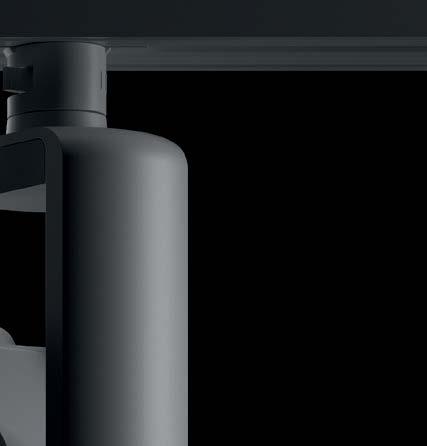





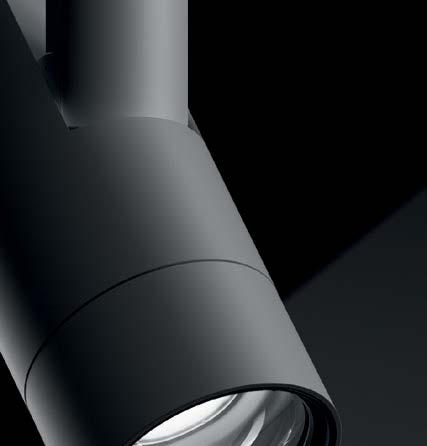
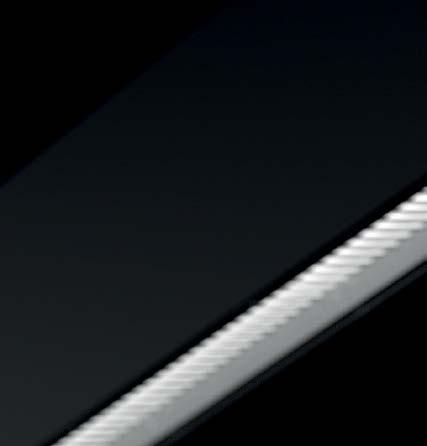





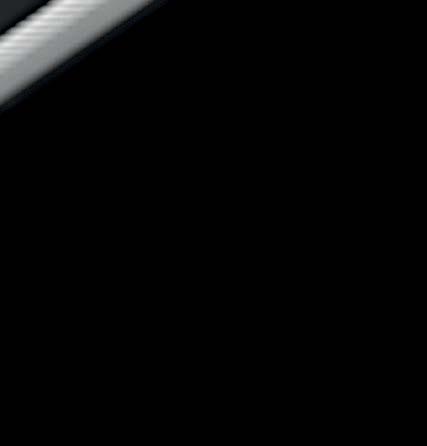















2 designing lighting global E Light is the fourth dimension of architecture Invia The modular 48V light structure Experience and configure Invia online: www.erco.com/invia-site
A second-generation owner-operated company with a reputation for cutting-edge technology and quality spanning nearly 40 years. WAC develops groundbreaking innovations in LEDs, materials engineering, electronics, and creative optical design that pave the way for endless possibilities. www.waclighting.com.cn

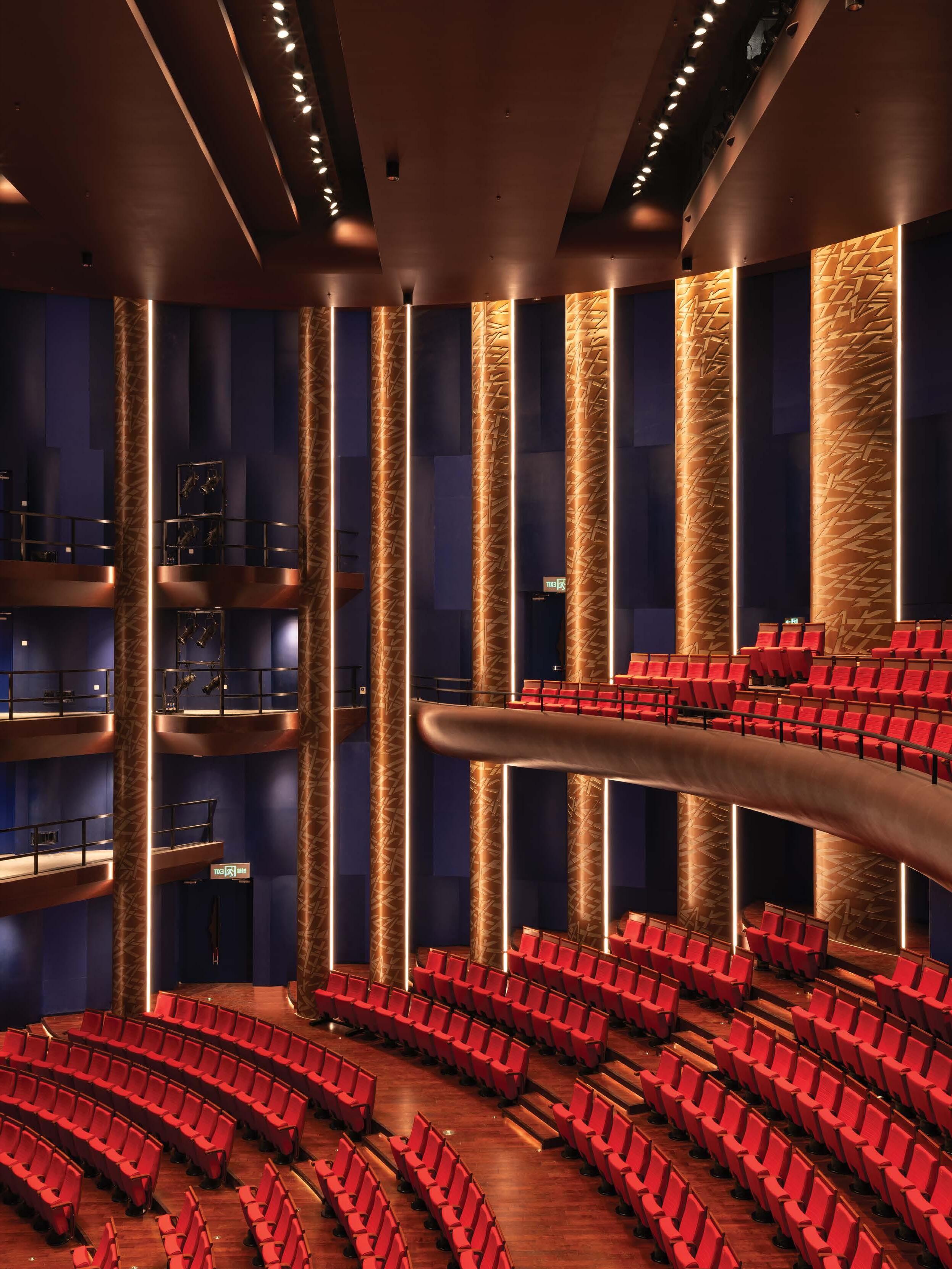
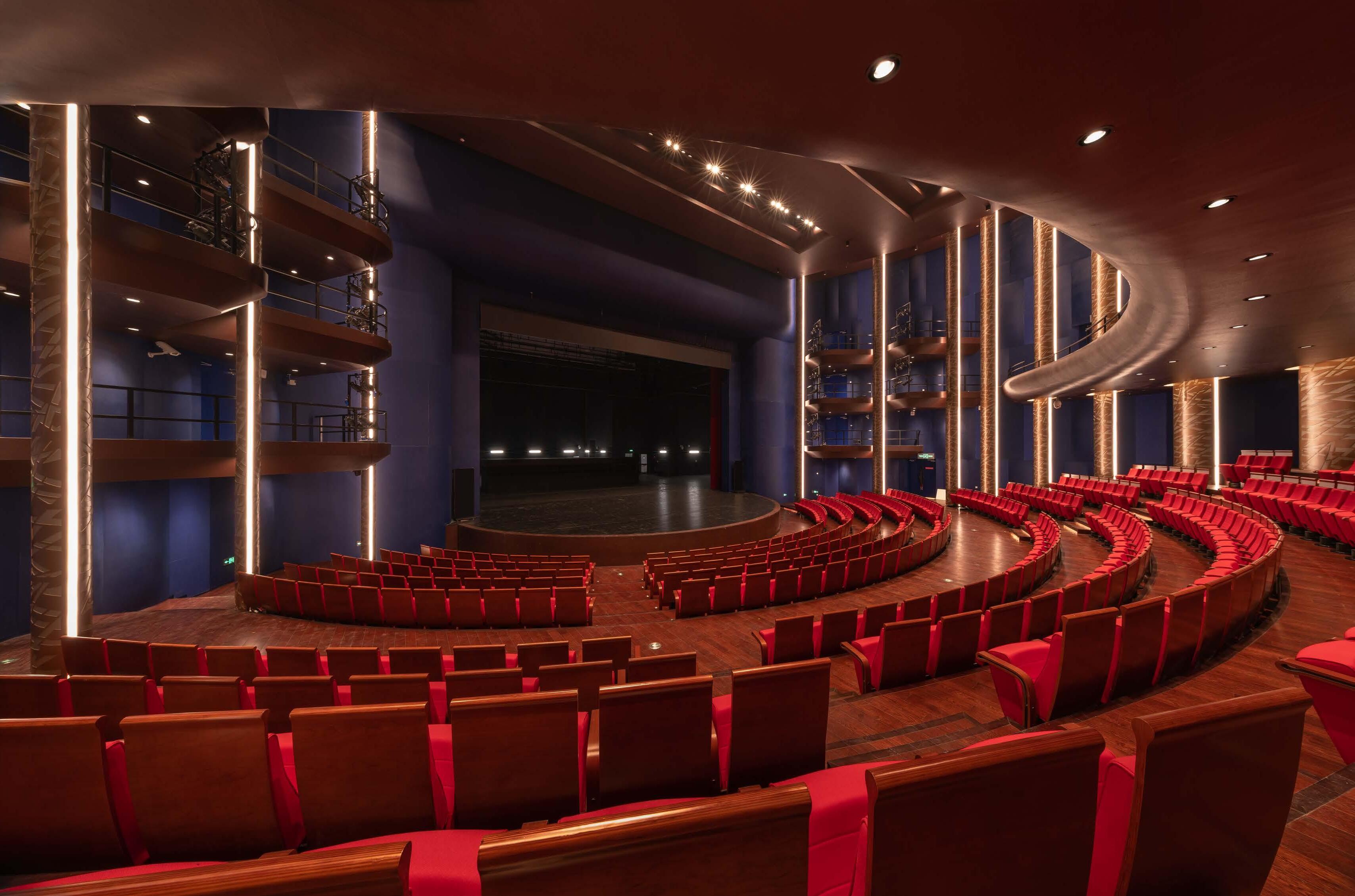

 Nantong Grand Theater
Nantong Grand Theater
CONTENTS table of
6 EDITOR’S NOTE
An introduction from our editor, Ray Molony.
8 PROJECT: GIMME THE MOONLIGHT
Lighting designers Vera Chu and Chia Huang Liao have harnessed the mysterious properties of moonlight to create a restrained and calming scheme at a spa in Shanghai.
12 PROJECT FILE
Some striking projects from around the world.
14
THE AI DESIGN REVOLUTION
The breathtaking advances in artificial intelligence technology are revolutionising a host of professions – will lighting design be one of them? Ray Molony speaks to some leading designers who have begun to incorporate its power into their work.
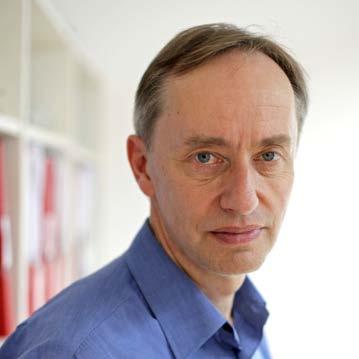
24
THE BUSINESS OF LIGHTING DESIGN™
Part-time hours, flexitime and working off-office are all ways in which design practices can retain key talent. dlg speaks to one designer who’s benefiting from the arrangement.
26
THE BUSINESS OF LIGHTING DESIGN™ - START-UPs
Start-up practices are often very creative – but they can find the business side of lighting design more challenging. Here veteran lighting designers Mark Sutton-Vane of Sutton Vane Associates advises on how to navigate fees, tenders and recruitment.
28 HOSPITALITY: THE RIVER OF LIGHT
The River Restaurant in the iconic Savoy Hotel in London has been transformed with lighting to match its upmarket Art Deco aesthetic.
30 DARK SKIES
An ambitious Dark Sky project in Wales has been garnering plaudits and awards for its sensitive and thoughtful approach to lighting.
32 LIGHTING AND HEALTH: INNOVATORS IN RESIDENTIAL CARE
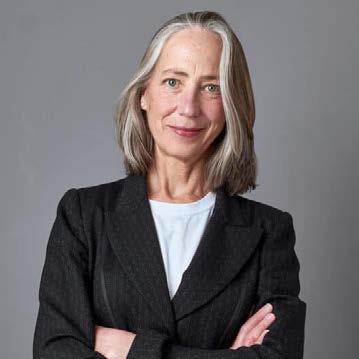
Dr Shelley James takes us through some exciting scientific breakthroughs in our understanding of light – and how they can help residents of care homes.
36 CONTROLS
For the first time, controls innovations – three, in fact – have made it to the podium at the Build Back Better Awards. We see what made them special.
38 PREVIEW: CIRCULAR LIGHTING LIVE 2023
This September, London is set to be the location for the lighting industry’s biggest event dedicated to its role in the circular economy. Ray Molony reports on movement that’s going from strength to strength.
40 INNOVATIONS
We curate the stand-out designs this quarter, including a nano luminaire that’s just 21mm diameter and only a startling 500 microns in elevation.
42 AWARDS DATES
Looking to enter your project for recognition and glory? We’ve got you covered. All the key dates you need to know about for all the major awards programmes.
43 TRADE SHOW CALENDAR
We mark your diary with all the big events in lighting design right into 2024.
44 ORGANISATION NEWS
The latest reports from the lighting design community and its representative bodies
45 NEXT ISSUE
We give you a heads up on what you can look forward to the next issues of designing lighting global
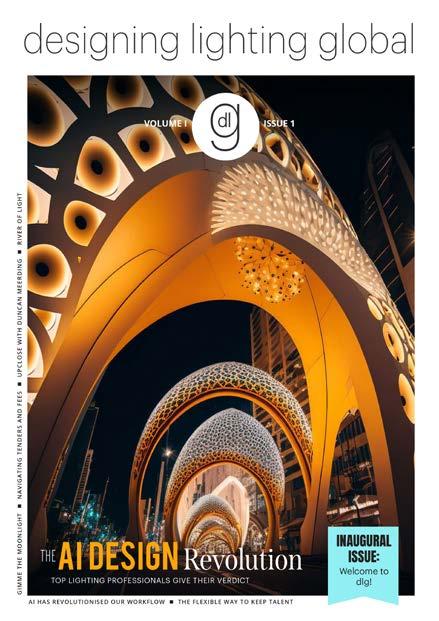
48
UP CLOSE: DUNCAN MEERDING
We meet award-winning product designer Duncan Meerding


4 designing lighting global
CONTRIBUTORS ON THE COVER AI-assisted Lighting
Design
VOLUME 1 ISSUE 1 2023
Thomas Paterson
Dan Weissman
Mark Sutton-Vane
Dr. Shelly James
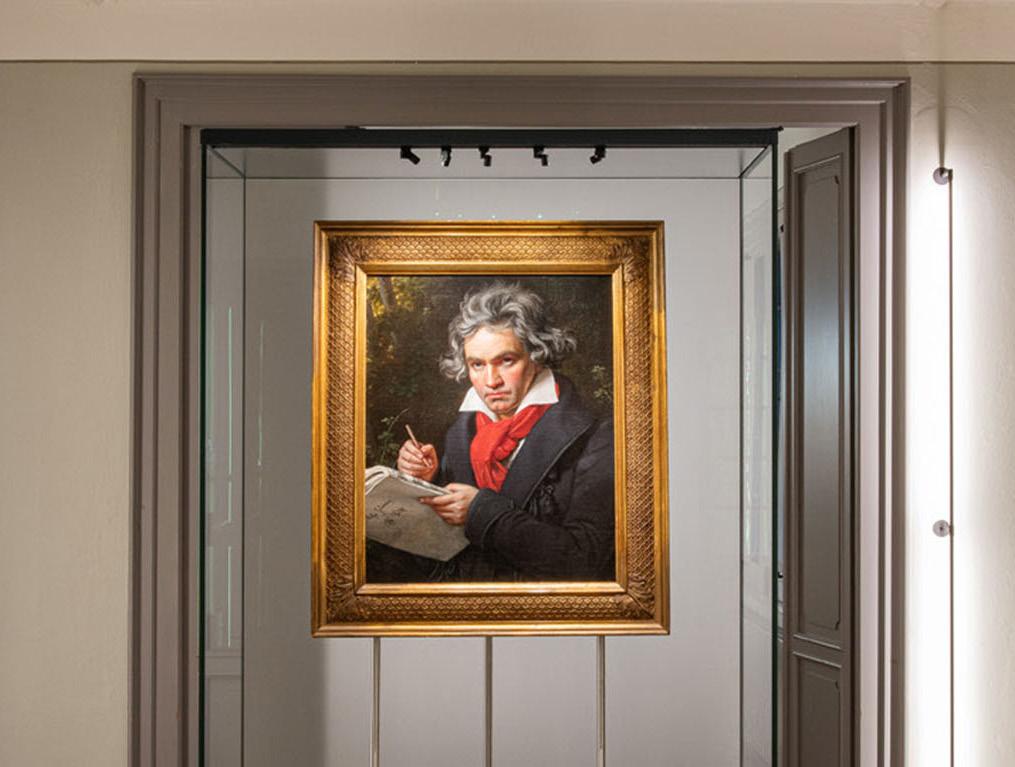

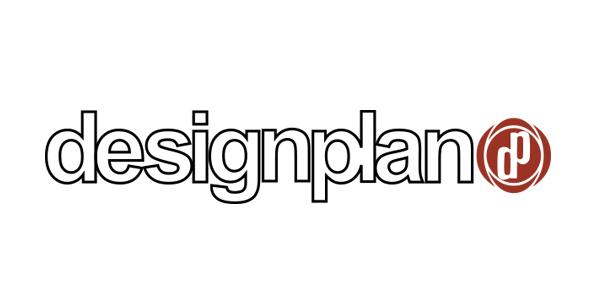

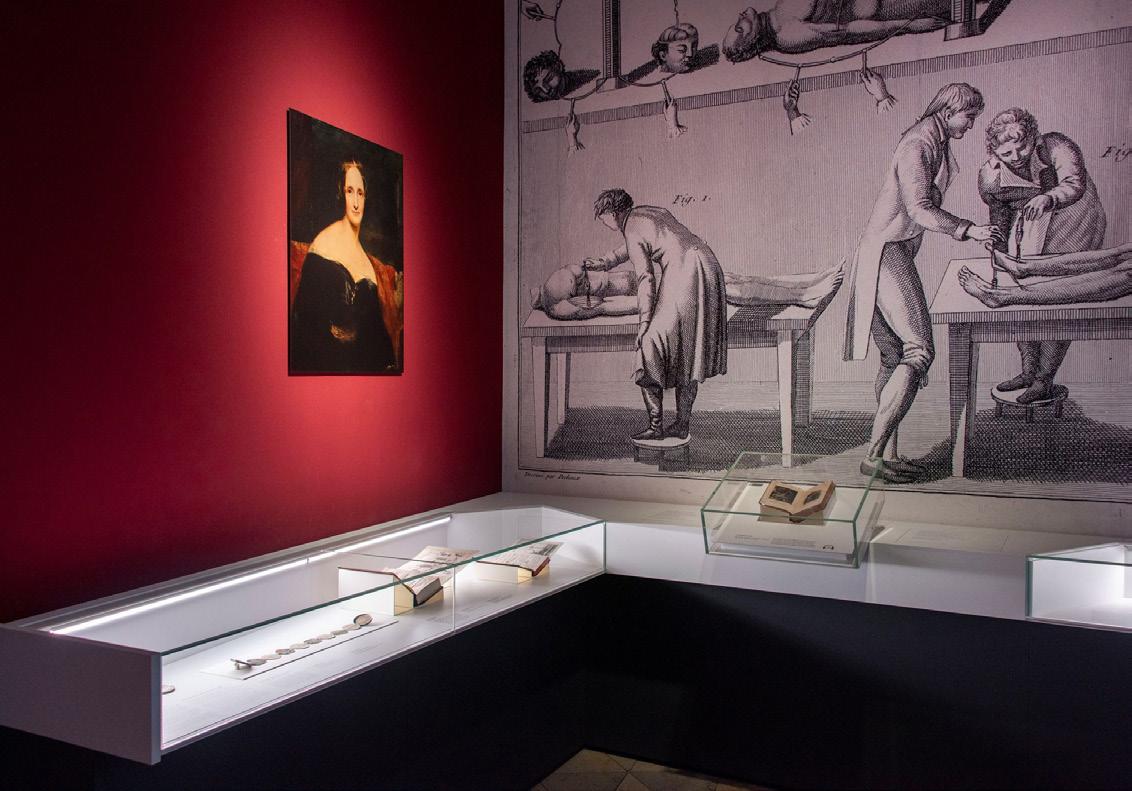

5 designing lighting global corporate friends ® Award-Winning Low Voltage Showcase and Picture Lights High Quality Lighting Solutions for Exhibitions & Display Case Applications 79 Trenton Avenue • Frenchtown, NJ 08825 • ph. 908-996-7710 • f. 908-996-7042 • www.designplan.com
Editor: Ray Molony

Publisher: Randy Reid
Associate Publisher, Advertising: Cliff Smith
Director of Audience Development: Angie Hullfish
Staff Writers: Parker Allen
Published by EdisonReport
1726C General George Patton Drive
Brentwood, TN 37027
Phone: +1 615 371 0961
www.designinglightingglobal.com

designing lighting global is focused on the Business of Lighting Design™ and provides business information to the lighting design community across the world. In addition to the website, designing lighting publishes bi-monthly online magazines featuring original content, interviews within the community and highlights successful and awardwinning lighting designs.
ISSN 2837-2352
The opinions expressed in this publication are those of the authors. They do not purport to reflect the opinions or views of designing lighting global or its management. The designations employed in this publication and the presentation of material therein do not imply the expression of any opinion whatsoever on the part of designing lighting global magazine concerning the legal status of any country, area or territory or of its authorities, or concerning the delimitation of its frontiers. © designing lighting global 2023.
Reproduction of the material contained in this publication may only be made with the written permission of designing lighting global.
A pivotal moment in lighting design.
First off, I’d like to say how honoured and excited I am to be editing this new publication at such a pivotal and exciting time in the lighting design profession. I look forward to working with Randy and the team to inspire and inform lighting professionals around the world.
After all, there is much to celebrate. We’ve successfully absorbed LEDs and dealt with much of the technical issues they’ve thrown up, such as low level dimming. Building owners across many sectors from commercial to hospitality to retail increasingly understand and appreciate the power of quality lighting design to achieve their business goals and create great places for people.
And the craft of lighting design continues to attract truly amazing talent, the fruits of whom we intend to celebrate in these pages.
But there are also challenges to face. The first of these, in my view, is effectively managing and minimising the environmental impact of our work while maintaining its creativity and diversity. Environmental metrics such as life cycle assessments and embodied carbon measures are still in their infancy, but it’s clear that they need to become second nature to us.
Another challenge – an exciting one – is finding ways to translate the scientific understanding of light’s impact on health and wellbeing into the real world. We have got off to something of a faltering start, but I’m optimistic that we will make effective use of this knowledge in due course, and we will do everything we can to share that knowledge.
A final challenge is getting the benefits of quality lighting design to everyone in our community, not just corporate high rollers. Here again we intend to share ideas and best practices so we can make our contribution to society at large.
Ray Molony EDITOR
6 designing lighting global EDITORIAL DIRECTOR’S NOTEPAD
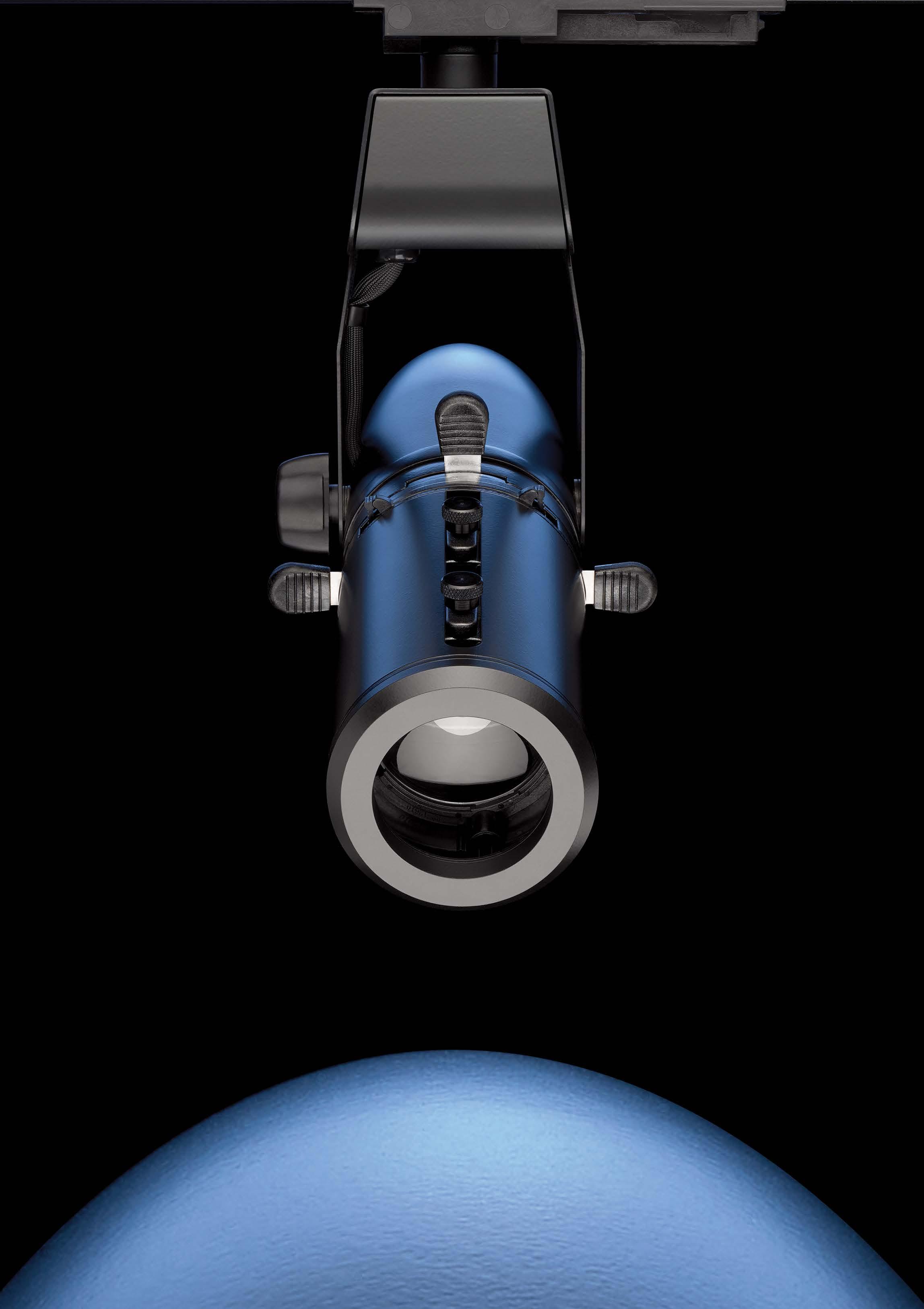


Lighting Services Inc 800 999- 9574 www.LightingServicesInc.com BPM Integrating Control Simplicity The BPM Series is a petite, architecturally designed LED image projector. At 12” in length, the BPM is a high performance instrument with 15,000+ CBCP at 19 watts. To learn more about the long list of professional grade features of the BPM Series, please visit our website. Lighting Services Inc The premier specialty lighting manufacturer LED IMAGE PROJECTOR 120/277V 12” Length, 19 watts, 15,000+ CBCP Beam Angles From 20º to 60º 3 Plane Shutters Glass or Metal “E” Size Gobo

GIMME THEmoonlight
The client’s design brief for the Green Massage upmarket spa in Shanghai was that it be a gentle and calming space with a sense of mystery.
The facility aims at providing soothing professional healthcare for busy urbanites in a private and elegant environment. Its unique selling point is that it integrates modern scientific techniques on the basis of the theory of traditional Chinese medicine. The interior is designed to reflect this dual mission and also articulate the high concept of the moon as a stilling and mysterious constant in our lives.
The Vermilion Zhou Design Group was tasked with using this lunar vision to create a customer journey through the many rooms which would emphasise the healing values of the spaces.

The grey tones and textures are intended to echo the surface of the moon, quietly diluting the restlessness of customers. There are no sharp angles and space is shaped by curves and lines
Lighting designers Vera Chu and Chia Huang Liao have harnessed the mysterious properties of moonlight to create a restrained and calming scheme at a spa in Shanghai.
9 designing lighting global PROJECT
PROJECT
of light. The ceiling is gently light-reflecting, like the moon reflecting sunlight and here it has become a soft filter, which removes and softens disturbances from outside.
The moon can be seen everywhere inside the space. An installation artwork ‘Moon Light’ created by the artist Yang Yong Liang is the poetic highlight in the space.
It comprises a 200 × 200 cm LED light box with acrylic painted on light film and a 500cm × 1000cm dark-coloured water pool to reflect the image. Yang Yong Liang says that the work ‘touches the audience’s romantic imagination conjuring the ancient folk belief that the moon was an illuminating disk.’
PROJECT CREDITS
Project: Green Massage, Shanghai
Client: Green SPA Management & Consultancy
Lighting Design: Vera Chu, Chia Huang Liao
Creative Design: Vermilion Zhou Design Group
Creative Director: Kuang Ming (Ray) Chou
Interior Design: Garvin Hung
The ball light and wall light also keep the lunar theme and guide the people step by step into their healing journey through the experience.
Lighting designers Vera Chu and Chia Huang Liao played a key role in bringing the properties of moonlight inside the spa to create a restrained and calming atmosphere.

The duo used cool white linear LED tape to gently graze the ceiling’s surface and then punctuated the space with suspended IC S1 pendants by Michael Anastassiades for Flos, which also has a planetary quality. ■

Furniture Fixtures and Equipment Design: Mavis Huang
Photographer: Yunpu Cai Artwork
Artist: Yang Yong Liang
Fixtures: Flos
Photographer: Yunpu Cai


11 designing lighting global
NDY Light
3 Parramatta Square

SYDNEY, AUSTRALIA
Lighting design practice NDY Light specified XD Profile’s Flat Freddie 14 to deliver an unobtrusive, continuous lighting for the dramatic stairwell at the heart of 3 Parramatta Square in Sydney, Australia. The 13 floor, 35,000 square metre workplace for NAB also features luminaires from Trilux, Light Culture, Euroluce and Koda Lighting. The base build architect was Johnson Pilton Walker while Woods Bagot handled the fit out.
12 designing lighting global PROJECT FILE
Photographer: Trevor Mein
Matrix Design
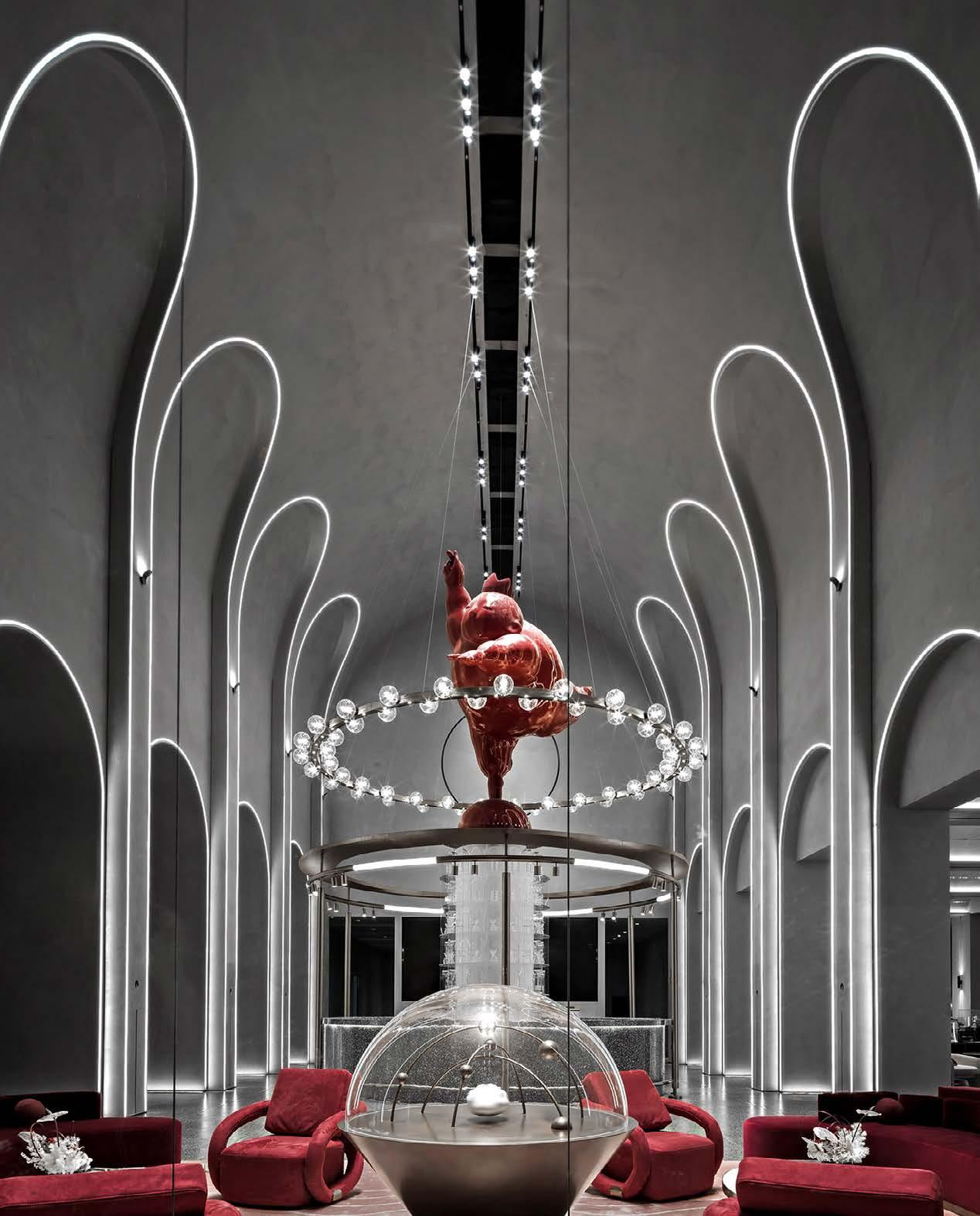
Shenzhen based Matrix Design were tasked with bringing drama to the sales hall at Jinke Cifi City Cover, a multifunctional pavilion in Shaoxing City, China. Track-mounted LED spots highlight the space while flexible linear LED are looped high in the space to draw the eye higher. A cool colour temperature complements to muted grey walls.

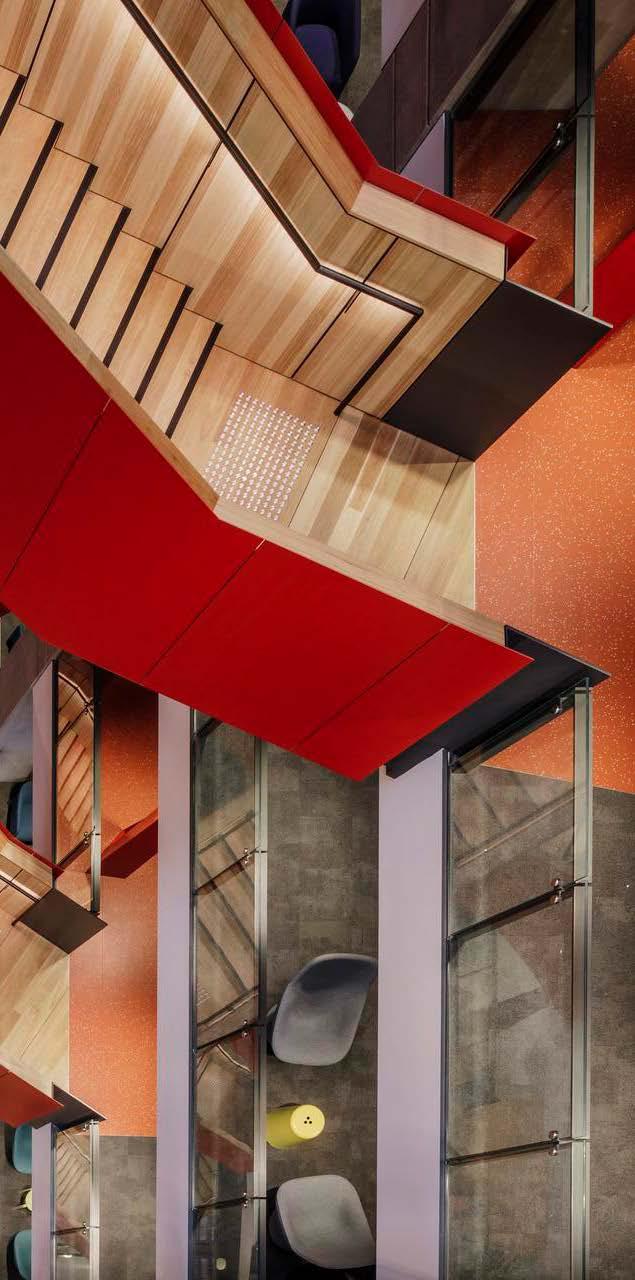
SoMA Lighting
SoMA Lighting used LEDFlex Ultra Bright in 120 RGB and Pro Profile 3409 Grey as in-ground and wall lights in the corridors of the 1Rebel gym in Dubai. The dynamic design creates a modern nightclub feel, enveloping the entire space, from the studios to the changing rooms, in an exhilarating, colour-changing environment.
Sales Hall at Jinke Cifi City Cover SHAOXING CITY, CHINA
1Rebel gym DUBAI, UAE
LIGHTING DESIGN AI REVOLUTION AND THE
 Midjourney is beginning to understand lighting techniques and already understands colour temperatures and concepts such as linear lighting.
Midjourney is beginning to understand lighting techniques and already understands colour temperatures and concepts such as linear lighting.
Version 4 of Midjourney was a step change in performance which allowed the technology to create compelling lit environments. ‘You can tell it to light it up this way, that it has to be a play of contrast, for instance,’ says Izhar. ‘You can say ’it has to be a brilliant and stunning scheme’ because it understands a very conversational language.’
From accountancy to graphic design to (gulp!) journalism, artificial intelligence is upending a swathe of white collar professions. So what impact will AI have on lighting design? Much of the initial interest has been in its increasing prowess at image generation, especially platforms such as Midjourney, DALL-E and Stable Diffusion, but one could easily image a role for it in fixture specification and documentation.
Faraz Izhar, lead lighting designer with Dubai-based multidisciplinary practice AE7, has been one of the pioneers in exploring the tech and its capabilities.

Faraz Izhar, lead lighting designer with Dubai-based multidisciplinary practice AE7, is incorporating AI-generated images into storyboards and mood boards at concept stage.

15 designing lighting global
The breathtaking advances in artificial intelligence technology are revolutionising a host of professions – will lighting design be one of them? Ray Molony speaks to some leading designers who have begun to incorporate its power into their work.
While clients don’t know how to achieve the lighting effects using practical luminaires, Izhar expects them to begin to generate ideas on their own and ask designers to make them practical.
Izhar says he started playing with AI and lighting design ‘out of curiosity'.
‘Lots of architects were experimenting with it already and they were using them to developed the concepts as inspirational images. So that’s how it caught my attention.

‘So I started exploring it, and at first I couldn’t get it working
satisfactorily until version 4 of Midjourney came out. It took me a bit of time but when I got the hang of it, I just couldn’t stop. I spent about three to four hours every weekend just talking to it, just generating images after images, environments after environments.
‘And the thing is that it’s getting more responsive as it learns. When Midjourney version 4 came along, the prompt writing
16 designing lighting global
‘If I tell it to imagine a building, maybe arctic or gothic style, maybe a hotel or a fort, and I tell it to intricately light up the facade elements, it starts doing that and then it starts extrapolating.’
− Faraz Izhar
techniques started getting easier, and it started responding very well to lighting.
‘If I tell it to imagine a building, maybe arctic or gothic style, maybe a hotel or a fort, and I tell it to intricately light up the facade elements, it starts doing that and then it starts extrapolating.

‘You can tell it to light it up this way, that it has to be a play of contrast, for instance. You can say ’it has to be a brilliant and stunning scheme’ because it understands a very conversational language.
‘It literally understands that language, so it will get what you are trying to say and it will light it up accordingly.
‘But what you cannot do is tell it to specifically light up a particular element such as a column with a linear LED – you can’t do that.
‘You can upload an image of a fort or an exterior but when
the output gets produced, it's not the same image. It will tweak it to suit its own understanding and its own thinking at that particular time.
‘But if you tell it more parameters which are close to your uploaded image, then it will produce something similar but not the exact image.’
He believes that AI-assisted lighting design – when you can upload an image and get render of a lighting scheme – is a matter of time.
‘The way this is progressing, the way the space is developing, I would say that that day is not far off. It's learning very fast and it's getting very responsive. I think it's going to happen very soon.’
And it's beginning to understand lighting techniques. Midjourney already understands colour temperatures and concepts such as linear lighting.
‘When I started, it didn’t do that,’ says Izhar.
Izhar believes that AI-assisted lighting design – when you can upload an image and get render of a lighting scheme – is a matter of time.
If requested, AI can copy a particular style such as that of the architect Zaha Hadid.

18 designing lighting global
So the key question is what will be the practical uses of AI to a lighting designer?
Izhar uses it as more of an inspirational tool at the moment and is including AI-generated images in his projects now.
'For instance I’ll use the images in a storyboard or a mood board as the initial concept. Usually what happens is that we designers tend to grab the reference images from Pinterest or from the Internet. So this is like your personalised Pinterest.’
It’s also useful for avoiding copyright issues, says Izhar. If there’s an image that you particularly like and want to use, you can upload it to the bot, tweak it and maybe add a bit of extra layers of lighting.
‘Then it will produce an image to a much similar intent. But crucially it won't be the same image and there won’t be a copyright issue. So I think it's quite useful for concept narratives.

‘When AI can produce lighting design renders I would say that would be the time for us to worry, because clients would be doing everything on their own. They just have to learn how to operate it and how to speak to it, which is not at all difficult.’
While clients don’t know how to achieve the lighting effects using practical luminaires, Izhar expects them to begin to generate ideas on their own [using the AI tool] and then approach the designers to say ‘this is the kind of thing that we’re looking for – now we want you to make it practical and constructible.
‘I would say that this could start happening in maybe a year or two. But it's going to happen soon. It's developing very fast at the moment.’
Are lighting designers in danger that the creative element is removed from them and that they’re merely asked to make a concept happen practically?


‘Yes, that's right. Just basically serving as glorified draftsman.
‘The technology is already creating quite a bit of stir in the realm of the digital art. The artists are upset because they believe it’s copying their styles and their ideas.
‘For example, if you search for certain illustrators on Google, rather than displaying their original images, Google is pulling images from the Midjourney archives instead, images which have been copied from their style.
‘Their intellectual property has been taken by the computer and not credited.’
He fears the same issue could arise in lighting design. ‘Perhaps you could have one of your projects being used by AI to create an image that somebody else uses, and you don't get any credit or any acknowledgment. It's doing that already.
‘You can literally tell it to copy any particular style such as Zaha Hadid’s, for example. It can copy any any famous architect. It can copy the styles and create the images based on what exists now and what exists around the world, which is made by those architects.’
He thinks it’s too early now for organisations such as the IALD to formulate a policy on AI but fears that day is fast approaching.
‘But the way this space is developing, I think that kind of scenario would happen, and they would have to think about it in two years maybe.' ■
19 designing lighting global
Artificial intelligence can also help with luminaire design. Faraz Izhar created these two concepts for suspended pendants using version 4 of Midjourney.
Thomas Paterson

DIRECTOR, LUX POPULI MEXICO CITY
Paterson studied AI as part of his mechatronics degree at the University of New South Wales in the 1990s. He believes the lack of meaningful data sets will hold back its effectiveness in lighting design.

20
‘AI is going to have a huge role in small optimisations, in taking the principles of a design and working out the right densities of lights in a system, working out the right timings etcetera.
But I think we're further away than people think, because the things that are dazzling people now like ChatGPT are fundamentally working in a space where there is a massive data set which is highly evaluated. So you can tell what's good writing and what's not by how much it sells, by click counts and so on.
But how do you actually evaluate whether a lighting design is good? Otherwise you're just steering towards an average of what's been published.
In terms of actual design thinking, it's millions of miles away because there's no data set that actually qualifies whether a lighting design served the client's interests, whether it worked with integrating with the facade or the building systems, with any of those aspects.
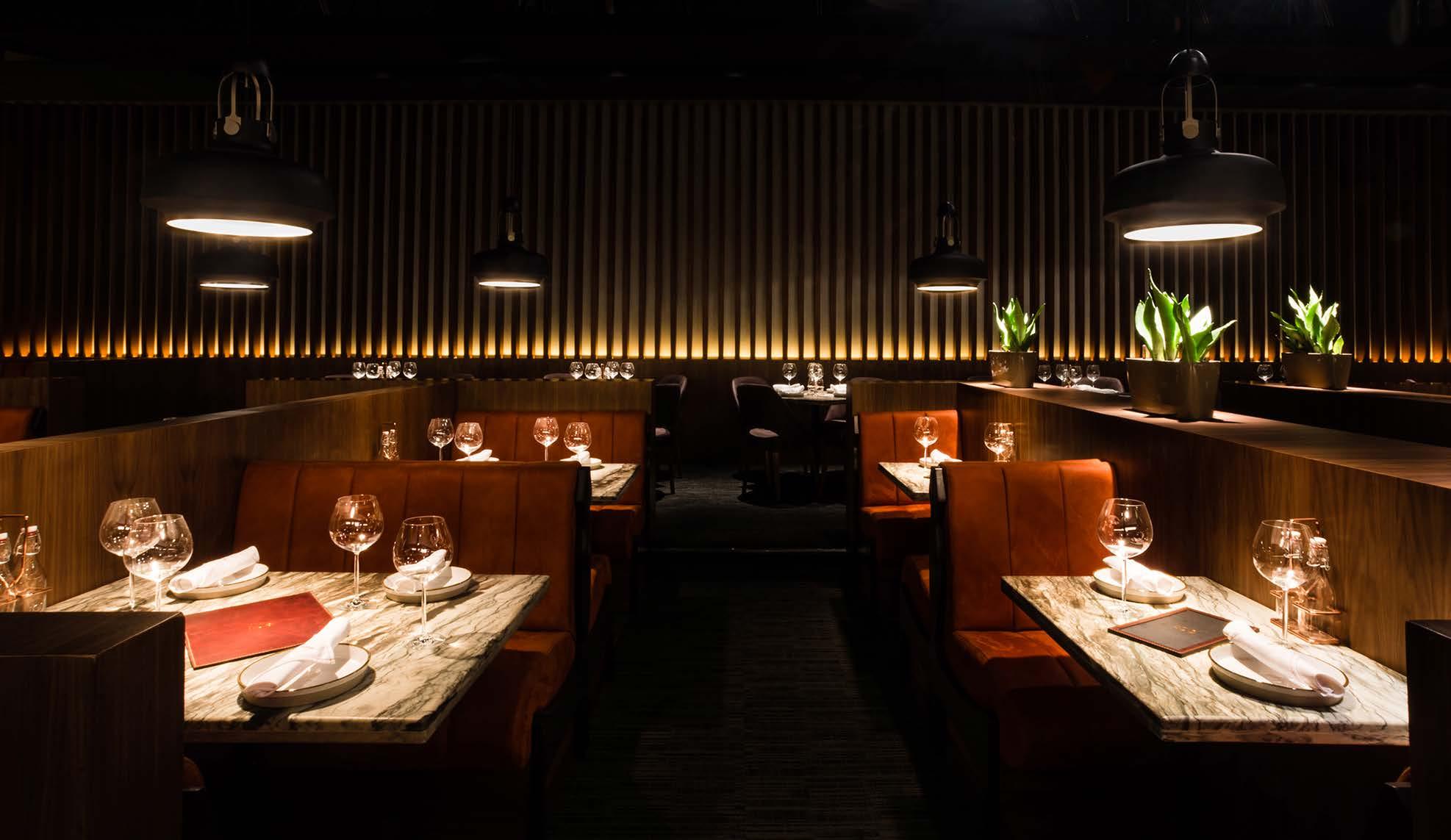

It’s too complicated, and there are just no data sets for lighting that are meaningful. Who can feed in 100,000 examples of projects with their documentation and with evaluation of what worked and what didn’t? Those data sets
don't exist and a lot of that information is confidential.
So I think it's going to be a useful tool. You should be able to identify which walls are wall washed and with what type of product, and what type of downlights, and so on. And in principle, AI should be able to lay out your plans, do all of your load scheduling, write your spec. There's a lot that it's going to be able to do.

I'm not particularly excited about it any more than any other tool, but I don't fear it. At our end of the lighting design market, we're doing truly crafted, truly detailed lighting design. People come to us because they want us to do innovative thinking. And innovative thinking means understanding stakeholders’ interests, understanding the history of a place, understanding how something is built, understanding how it will be constructed, which are two different things.
That huge breadth of knowledge, plus the knowledge of psychology for brand and identity and all these sorts of things are all dependent on much research and knowledge, and we exist because people want that. Otherwise, I’ll go to a sales rep lighting designer. So a lighting designer who is threatened by AI is not a very good lighting designer.’ ■
The Nos restaurant in Lima, Peru by Lux Populi. The practice worked in close cooperation with Taller MER of Miami on the project.
Photo Credit: Laura Arroyo and Thomas Paterson
The Momentary arts complex in Bentonville, Arkansas by Lux Populi. The architect is Wheeler Kearns Architects.
Photo Credit: Tom Harris.
"A lighting designer who’s threatened by AI is not a very good lighting designer."
AI HAS REVOLUTIONISED OUR WORK FLOW
Dan Weissman, senior associate at Lam Partners and director of Lam Labs, predicts that AI will increasingly be able to take on mundane and bureaucratic tasks, freeing up designers to focus on creativity.


Using AI to generate visual images can serve a particular purpose. As a tool for idea generation or iteration, it has some interesting possibilities. For instance, I’ll render an image of a design concept in 3ds Max and then upload it to DALL-E and [the AI] will offer alternative design options. But to me, this isn’t that interesting in the long run.
What interests me more is using AI-based tools embedded in other things. For instance, in the past a render used to take a couple of minutes to render out; it’s very pixellated; it’s pretty grainy. Now we’ve started using an AI DeNoise script with our render engine, iRay. The AI samples all the pixels and guesses at how it’s going to look and within a second or two, the image looks relatively realistic.
The result is that iRay is now exceedingly fast and we’re basically working in real time in digital space. We’re literally moving around a model in real time.
We’re able to work on the thing itself, rather than a proxy. And it’s not just radiosity, it’s all the lighting phenomena.
We’ve been using AI embedded in this programme for four years to significant success, and it’s basically revolutionised the work flow at our office.
I don’t waste time trying to sell a client on an idea with diagrams – that’s silly – I just jump right in and model up some options for them in real time. I’ll pull up the programme, move around in real
time, they’ll say ‘I don’t like that’ and we’ll move things around.
So AI isn’t necessary to me to generate scenes or concepts. What I want to use it for is to eliminate the most annoying parts of the design process.
There are three main processes [in lighting design]: visualisation, documentation and specification. I see AI being able to participate in various ways in these, but under the surface.
With documentation, AI can tag hundreds of different items on a drawing. I want an AI that will automatically sweep through and tag every single fixture with the appropriate tag, and keep that tag from overlapping the fixture, and make it readable at all scales.
For me, the promise of AI is taking out all the annoying stuff. I read a great quote online: ‘We don’t need to AI to do art, we need to do all the other shit so human beings can do art’. ■
22 designing lighting global
Photo Credit: Picture Office
Dan Weissman

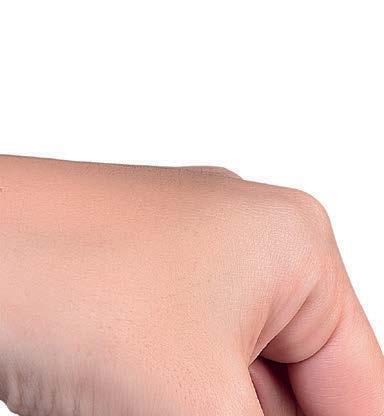
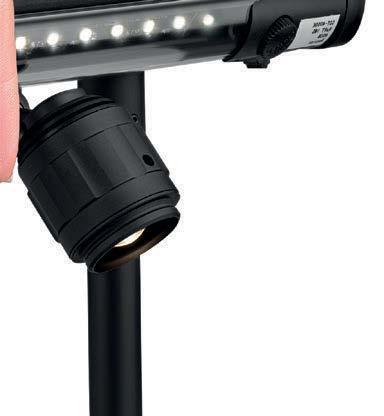
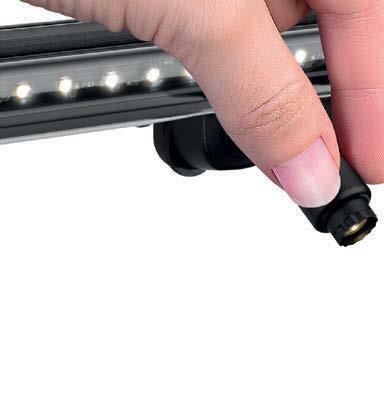


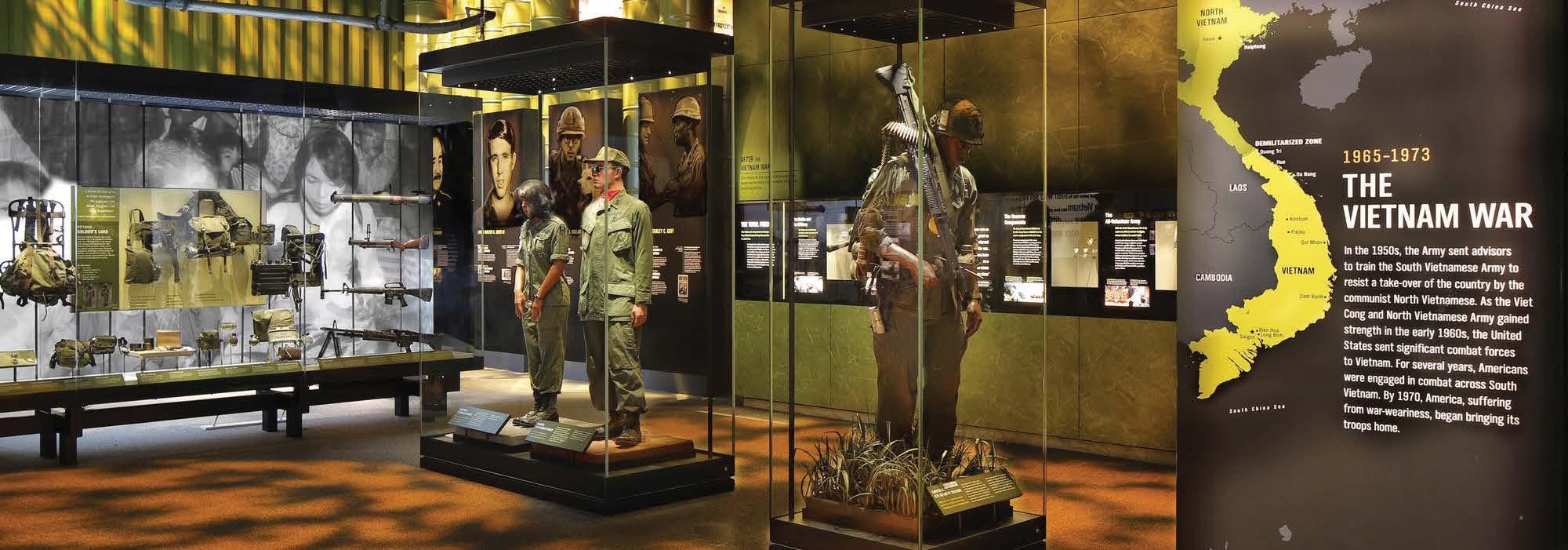
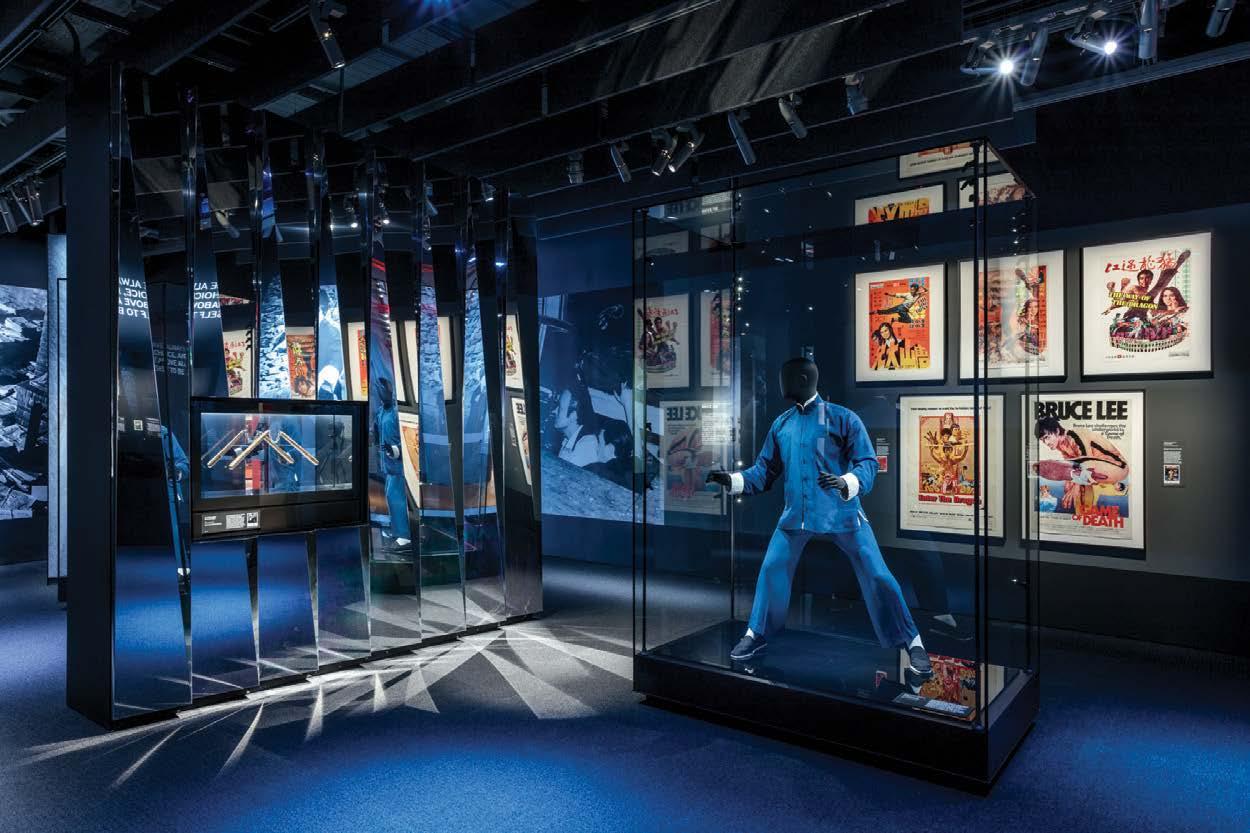

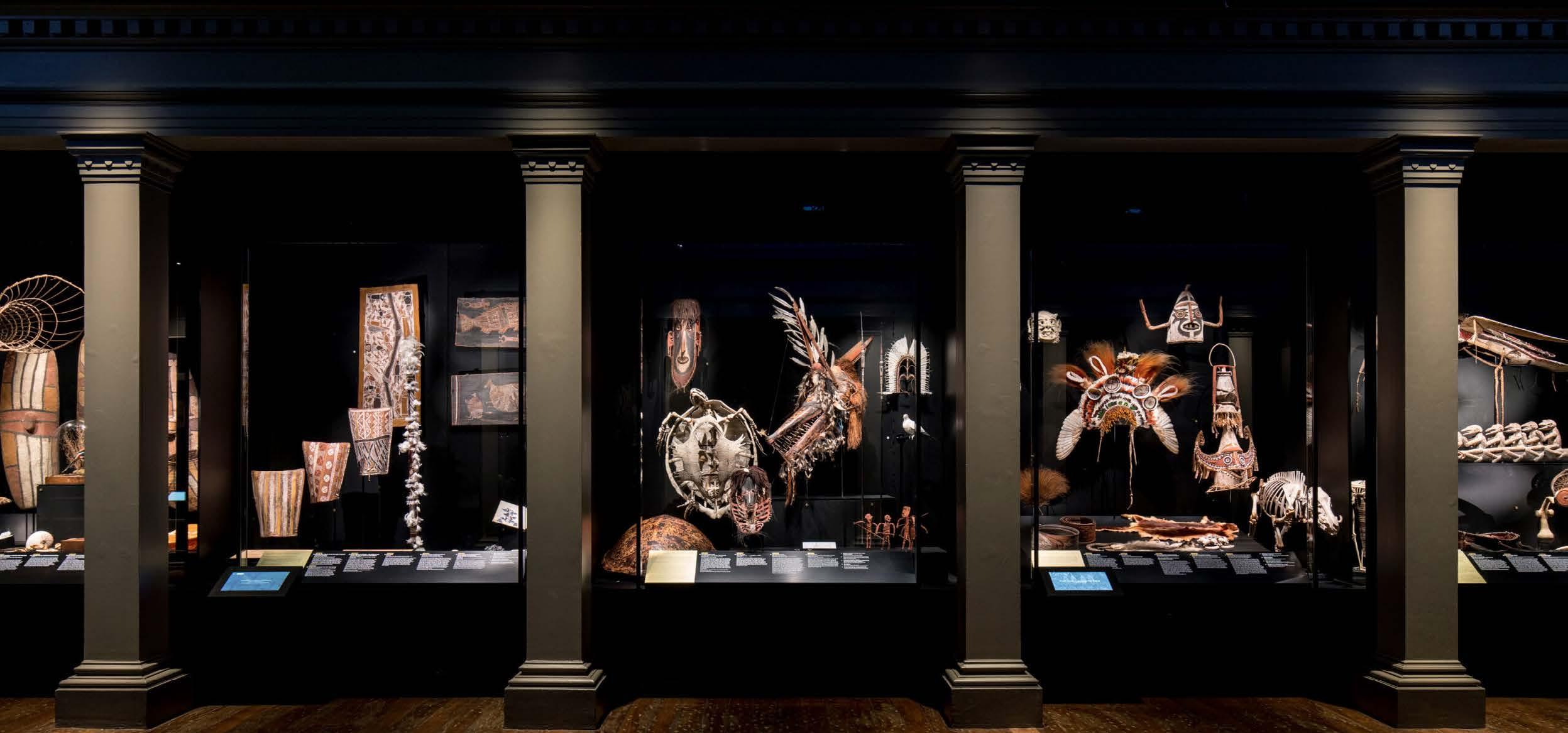
23 designing lighting global Providing advanced museum lighting products & services with Fiber Optic and LED technology. • Conservation • Functionality • Color & Focus quality 12201 NW 35 Ste 534 Coral Springs, FL 33065 info@luxam.com For more information visit L UX A M . C O M 954-775-7254 C ORA L SPR I NG S • L O NDO N • P A RI S • S H ANG H A I LUX A M SP EC IAL I Z I N G I N D I SPLA Y CAS E LI G HTIN G WO RLD W ID E S IN C E 199 5 Providing advanced museum lighting products & services with Fiber Optic and LED technology. • Conservation • Functionality • Color & Focus quality 12201 NW 35 Ste 534 Coral Springs, FL 33065 info@luxam.com For more information visit L UX A M . C O M 954-775-7254 C ORA L SPR I NG S • L O NDO N • P A RI S • S H ANG H A I LUX A M SP EC IAL I Z I N G I N D I SPLA Y CAS E LI G HTIN G WO RLD W ID E S IN C E 199 5 Providing advanced museum lighting products & services with Fiber Optic and LED technology. • Conservation • Functionality • Color & Focus quality 12201 NW 35 Ste 534 Coral Springs, FL 33065 info@luxam.com For more information visit L UX A M . C O M 954-775-7254 C ORA L SPR I NG S • L O NDO N • P A RI S • S H ANG H A I LUX A M SP EC IAL I Z I N G I N D I SPLA Y CAS E LI G HTIN G WO RLD W ID E S IN C E 199 5
Academy Museum of Motion Pictures © Joshua White
Australian Museum @ Rosie Hastie
Bavarian National Museum @ Raffael Pollak
THE FLEXIBLE WAY to keep talent
Flexible working has become a familiar term in recent years since the surge of people working from home due to the effects of the pandemic. But the term actually encompasses a wide range of working opportunities, including part-time hours, flexitime and working in locations other than a fixed office.

For award-winning UK lighting design practice Michael Grubb Studio, flexible working is nothing new. The studio offered several options of flexible working to employees before it became commonplace, with many team members working around school hours and part-time to suit their personal commitments and create a healthy work/ life balance.

24 designing lighting global
THE BUSINESS OF LIGHTING DESIGN™
Rachael Flint, associate at Michael Grubb Studio in the UK, wants to see more flexible working options offered within the lighting design industry.
Photo Credit: Gorodenkoff
This is one of the reasons that Rachael Flint, associate at Michael Grubb Studio, was attracted to the role.
‘Prior to joining Michael Grubb Studio I had been on maternity leave, so I was delighted when Michael agreed to my request of a phased return to work and ongoing part time hours.
‘Returning to work after having a baby is a huge adjustment, and I was keen to do a phased return to ensure I could give my work 100 percent as I adjusted to my new routine. I started at two days a week and moved up to four days a week. Working part time as well as working from home enables me to keep a good work-life balance while my child is young.’
Rachael also reflected more broadly on how flexible working undoubtedly allows designers to have more control over the locations in which they work and often, their pattern of work too, which is often seen to help manage and enhance a better work-life balance.
Flexible working has been proven to reduce stress and increase overall job satisfaction as employees can schedule their work around their children, health, and other needs. It also reduces the need to commute to the office, which not only has a positive impact on wellbeing, reducing the additional stress this can cause, but is also beneficial for the environment by reducing the number of cars on the road and therefore lowering carbon emissions.
Rachael states, “The key thing with flexible working is trust from leadership, and Michael intrinsically trusts the team to get the job done. Other members of the team work part time to create a better work/life balance and several team members work around school hours. By allowing people the space and time to conduct their work in harmony with other commitments in their life, this makes the team feel happier, valued, and empowered to do their jobs and live their lives.’
Yet flexibility in the architectural and construction sectors is notoriously difficult to come by. A 2010 study by students at Nottingham Business School found that – after interviewing a cross-section of chartered architects employed in a variety of settings – there were significant concerns over maintaining a satisfactory work-life balance within the sector. Long
hours, travel and a lack of general flexibility around work were all cited as reasons why architects felt despondent in their jobs.
The AIA Compensation Survey Report 2021 recorded that 72 percent of architecture firms offered full-time or part-time remote working options in 2020, up from only 13 percent in 2019.
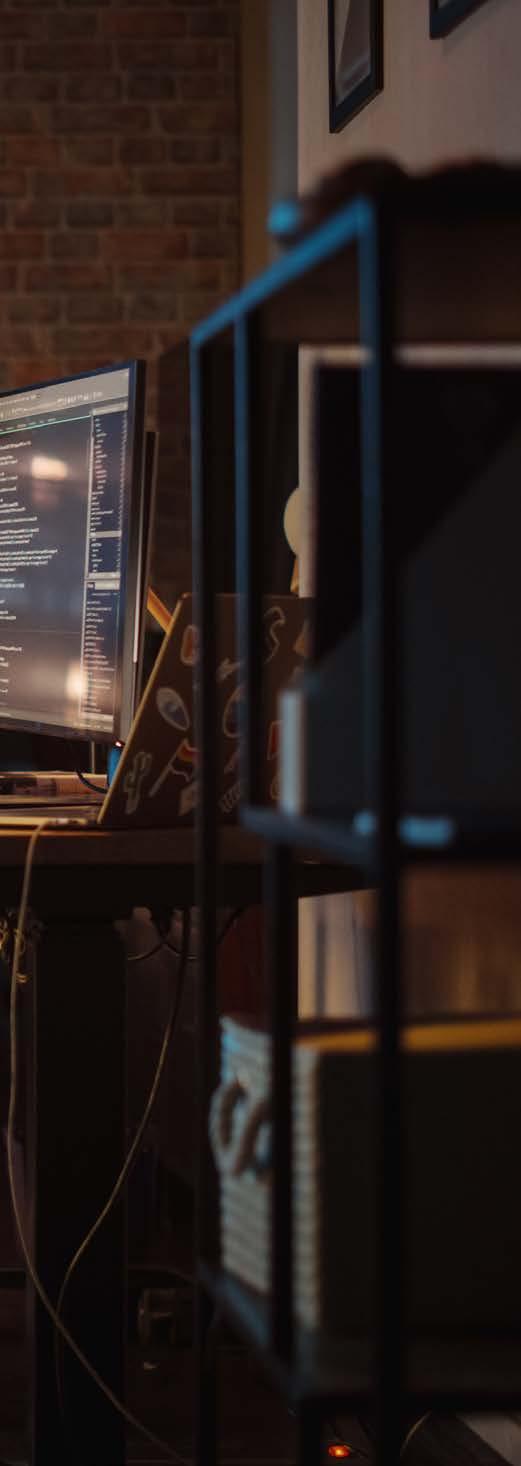
However, despite this significant shift in flexible working, it seems that many firms are yet to fully adapt to and embrace flexible working as standard.
Rachael adds, ‘Many of my friends have referred to my role as a ‘unicorn role’, in that it’s too good to be true. It seems almost unheard of to have this ability to work so flexibly around my child, home life and personal needs. I believe this should be offered to everybody, not just for the benefit of employees but for the benefits it ultimately offers businesses too.’
Greater flexibility in the workplace could also be the silver bullet for levelling the gender playing field in the industry. A survey by Architects Journal discovered that a larger percentage of women than men worked part time, 18 percent compared to 7 percent, and more women worked regularly from home, 60 percen of women compared to 51 percent of men.
Research released earlier this year shows that a huge 52 percent of women in the UK workforce have stated that they have considered leaving or have left their role due to a lack of flexibility.
Rachael shares how flexible working arrangements, for both herself and her husband, has provided equality not just between gender roles but between parenthood and working roles. ‘Having a baby is a huge change for the entire family, not just a mother, with discussions around childcare and partners taking on more of a parental role on the return to work. My phased return to work made this process so much easier, rather than it being a huge immediate change, it was instead a smoother transition.
’Working part-time allows me to enjoy motherhood without feeling conflicted about my roles between home and work. This way I can give full commitment to my role when I am working, and when I’m not I can take my child to appointments and do what I need to for my family. Flexible working has allowed me to fulfil both of those roles better, as both a mother and an employee.
‘It’s invaluable having both my husband and I working flexibly, and this creates an equality between us as we can both be available to do nursery pickups or drop-offs when the other is working away.
‘If one of us was working full-time in the office, we wouldn’t be able to do our careers in the same way we do now. Him being flexible supports my career so that I can do all aspects of my job well, and me being flexible supports his career in turn.
‘I would love to see more flexible working options offered within the lighting design industry. This is something I strongly believe will help encourage equality in the industry and wider sector.’ ■
25 designing lighting global
THE BUSINESS OF LIGHTING DESIGN™
Part-time hours, flexitime and working off-office are all ways in which design practices can retain key talent. dlg speaks to one designer who’s benefiting from the arrangement.
Sutton Vane Associates’ strategy for York Minster in the UK was named winner of the Heritage Project of the Year in the Lighting Design Awards. A major part of the lighting and servicing strategy was to conceal the luminaires, associated drivers, cabling and containment as much as possible to ensure that the visible services were kept to a minimum, whilst allowing the ‘lighting effect’ to take centre stage.
 York Minster
Photo Credit: James Newton
York Minster
Photo Credit: James Newton
Designers
NAVIGATING TENDERS AND FEES
are key for new practices
Start-up practices are often very creative – but they can find the business side of lighting design more challenging. Here, veteran lighting designer Mark Sutton-Vane of Sutton Vane Associates advises on how to navigate fees, tenders and recruitment.

Lighting design is an exciting and creative industry – but the business of lighting design has to be navigated carefully.
Obviously, the first thing a start-up practice has to do is get commissions. Once the principal starts building a reputation for delivering good projects then, with luck, work will arrive. Nothing is more satisfying than a client coming back for another project.
Often the designer has to pitch against other more established practices to win a project. The client putting together the list of pitching practices may not have much knowledge of the reputations of the designers. And sometimes the independent designers are pitching against companies who supply fittings. The latter is a valid way of working, but both approaches give the client different results.
The independent design practice has to be paid a fee, which should give a higher quality result as it can choose whatever equipment is best for the job. The company supplying fittings will have a tiny or zero fee but will only specify what they supply and will be tempted to specify as much as possible. This can end up costing the client more.
Some wise clients buy a small amount of a reputable lighting designer’s time to advise them on the process of hiring a designer. They sometimes keep this designer on board through the project to keep an eye on the lighting designer and make sure they are doing everything properly.
Some clients will choose a designer on aspects that are irrelevant to the quality of the final job, like the age of the designers, or ‘showing inspiration’ when the project needs solid lighting experience not inspiration.
There is a truism in all kinds of business that there are three aspects to a project: quality, economy and speed, the client can only have two of these at once.
So, for example a project where quality is not needed can have economy and speed. In a tender process the pitching designers will usually be rated on quality and price. The higher the quality of the designer the more likely they are to win.
And the lower the price the more likely they are to win. Most projects have a fixed speed – it is known when the project will be completed. But high quality is unlikely to have a low price which is why the tender process often does not always award a project to the best designer for the job.
Then there are projects where the design team has to re-tender half way through a project. It’s really frustrating – a lot of work. And pride in doing a good job can be destroyed. If the designer who started the project loses the project half way through then who is responsible for the design? It’s hard to see the advantages of re-tendering half way through as a matter of course. Yes, if a designer has not performed then take them off the project and retender. Clients seem to forget that the memories of all the details and why decisions were made are very important and much of that gets lost when a designer is changed.
Lighting design companies all suffer from designers moving from one practice to another too often. Young designers can get told at university that it is good to change jobs after a year. But this isn’t what employers want and say it looks bad on a CV. Many projects last longer than a year, so the designer often doesn’t see their work finished. That’s a huge part of the learning process and it’s exciting to see your design built. In one year, a young designer has hardly settled in and become familiar with the details of projects.
It would be wonderful if the education establishments could teach designers what they need to know in the real world of design. That is clear communication of lighting written in an appropriate style, experience of the real world – not academic process. An understanding of real ways that light works on site. And knowledge of costs and manufacturing methods. What a positive effect that would have on the lighting design industry. ■
27 designing lighting global
Mark Sutton-Vane is the founder of London-based practice Sutton Vane Associates Lighting Design. www.sva.co.uk
with real world experience of design, the ability to communicate about lighting clearly and an understanding of real ways that light works on site are invaluable, say Mark Sutton-Vane
RIVER OF LIGHT
The River Restaurant in the iconic Savoy Hotel in London has been transformed with lighting to match its upmarket Art Deco aesthetic.

The former Kaspar’s dining location in the Savoy Hotel in London has been reinvented as the River Restaurant, with Gordon Ramsay brought in to oversee the menu. The Art Deco dining room offers guests stunning views over the Thames and specialises in seafood for its all-day dining menu.
The concept by interior designer Russell Sage Studio was inspired by the restaurant’s riverside location and the hotel’s Art Deco heritage.
The lighting design brief was to help create a calm, relaxed, loungey space, sitting comfortably within the context of this glamorous hotel. Victoria Jerram Lighting Design used its knowledge and experience of designing luxury spaces, meeting the brief by incorporating soft, indirect light to create a warm, welcoming ambience throughout the space.
HOSPITALITY
River Restaurant
PROJECT CREDITS
Project: The River Restaurant, The Savoy


Location: London, UK
Client: Gordon Ramsay Restaurants
Lighting Design: Victoria Jerram Limited
Interior Designer: Russell Sage Studio
Lighting Schedule: IBL, Lucent Lighting, Light Graphix, Light Ideas, Nocturne Workshop
Photography: Courtesy of Gordon Ramsay Restaurants
A key constraint on the project was the limited budget which prohibited architectural and fixed joinery changes and necessitated the re-use of the existing lighting control system.
The large, river-facing windows and the doors to the day-lit Thames Foyer atrium provide an abundance of cool, natural light for daytime dining and the lighting design responded to this with the use of warm dimming technology. Dimming the lights as evening service commences automatically warms the ambient colour temperature to achieve an intimate night-time dining experience.
Warm dimming technology was used extensively for a coherent feel, from the ceiling coffers and window coves to the bespoke ceiling and entrance column lights.
The close collaboration with Simon Day of Nocture Workshop on the bespoke decorative lighting continued with Victoria Jerram specifying opal glass and extra warm white lamps for the chandelier above the bar, and the bar table lamps, to ensure that the feature lighting cast a soft, warm glow, creating a glare free focal point for the space.
A touch of sparkle was added as a contrast to the dominant soft ambient lighting through the addition of miniature spotlights focused on the artwork and the planting.

The use of highly polished and mirrored finishes also has the effect of further animating the space.
The end result is a glamorous, stylish dining space befitting an iconic location such as The Savoy. The restaurant achieves the aesthetic of bringing to life the bygone luxury of art deco-inspired ocean liners, while the lighting design achieves a calm, elegant atmosphere that will enchant diners and create a truly unforgettable experience. ■
29 designing lighting global HOSPITALITY
HOW DARK IS MY VALLEY
An ambitious Dark Sky project in Wales has been garnering plaudits and awards for its sensitive and thoughtful approach to lighting.
Plas Y Brenin is an ambitious transformation of an outdoor activity centre Snowdonia.
The area attracts thousands of visitors annually, but has been suffering from light pollution and glare that’s visible for miles.
Lighting design practice Dark Source, led by founder Kerem Asfuroglu, was brought in by the Snowdonia National Park Authority, in collaboration with Prosiect Nos, to enhance the



night-time experience while cutting energy and the impact on wildlife.
Existing lighting mostly consisted of fluorescent bulkheads and LED floodlights, which reduced the site’s legibility due to glare and uncontrolled light distribution.
Undoing light pollution is something that has to be done with a holistic vision, one which takes the site experience and
30 designing lighting global
The site now meets the dark sky quality required and delivers an engaging night-time experience.
Additionally, bats have returned to the site to forage around the hedgerows that over-illuminated before.

As a byproduct of the switch to LEDs, energy use was cut by 1.9 tonnes of CO2e (8000kW) annually.
‘This is what outdoor projects should be like’, ‘an absolute labour of love’, ‘a simple aspiration but wow, is it hard to achieve in practice’…
The expert judges in the lighting category of the Build Back Better Awards heaped praise on the Plas Y Brenin project which they awarded both a Build Back Better Gold and Green award. ■
LIGHTING SCHEDULE
character into consideration as well as refurbishing every existing light source.

The large majority of the lighting at Plas Y Brenin is achieved below the eye level and at door height, focusing the light on the horizontal plane whilst keeping it human scale.

All luminaires were made to face downwards to avoid upwards travelling light. All floodlights were removed.
Lighting suppliers include Heper, Stoane Lighting, Atrium, Flos, Mesh Lighting, Luce & Light, Thorlux and Osram
31 designing lighting global
Photography: Dylan Parry Evans, Karl Midlane, Dani Robertson, Kerem Asfuroglu
INNOVATORS IN light at the end of the tunnel RESIDENTIAL HEALTHCARE:

Dr.

32 designing lighting global
Shelly James on how scientific breakthroughs in our understanding of light can help residents of care homes
LIGHT & HEALTH
Pioneering healthcare professionals are battling the odds to invest in dynamic lighting solutions that actively support the sleep-wake cycle of their residents and staff. They are seeing first hand what a powerful difference that can make. These innovative care home managers point to a 32% reduction in falls, 8% reduction in anti-anxiety use and improved staff health and engagement.
The science backs up the heart-warming stories from the real world, with a growing number of studies pointing to the short and longer-term effects of circadian approaches to lighting. At the same time, leading academics are keen to highlight the complexities involved and warn against drawing simplistic conclusions: it is almost impossible to separate changes to the lights from other dimensions of the environment including staff attitudes, multiple underlying medical conditions and wide variations in visual and biological response in this ageing population.
Sleep and disruption to the circadian rhythm are critical symptoms of dementia, contributing to the night time wandering and confusion that are associated with increased risk of falls, depression and memory loss.
While drugs can deal with the most obvious symptoms of insomnia and agitation, they do not tackle the underlying cause: most residential care homes simply do not offer the contrast between bright, active days and dark, quiet nights that the ageing body clock needs to stay on track.
A growing body of scientific evidence suggests that changes to the lighting has the potential to improve the health and well-being of people living with dementia as well as the dedicated teams who care for them. In this context, it makes sense to invest in an environment that actively supports the sleep and wider mental health of resident and staff alike.
And yet, this is surprisingly rare as these small businesses operating from buildings that are often in desperate need of basic repairs struggle to raise the capital budgets needed to upgrade the lighting.
However, there are shining examples of best practice. Jo Cheshire, the Marketing Director at WCS Care explained why they reject many of the ‘high tech’ gadgets because they often end up in a drawer. In contrast, the lighting is embedded in the structure of the building and runs along in the background. She highlights the problem of retrofitting new lighting while maintaining the daily routine in a busy residential home.
Jo is working with the lighting designer John Bullock and the academic team at Oxford University to refine a model and specification that makes it possible and feasible for the UK care sector to adopt this approach. She points to the potential ripple effects if the approach was adopted across the industry, linking into reduced hospital admissions and reduced costs. But for Jo, resident health and wellbeing is always central to everything they do.
Jo points to her experience of innovating with acoustic monitoring: a system that allows night teams to be aware of unusual movement or sounds in a residents’ room without needing to physically go in and switch the lights on. ‘We were the first in the UK to introduce acoustics. We were able
to evidence that this had a very big impact on reduction of falls at night and during the day for residents.’
That technology is now being funded through the NHS Transformation Directorate. Jo and the team at WCS Care would like to see a similar direction of travel for circadian lighting. If that funding is made available, the approach will become a more mainstream component, not only for new builds but for retrofit to older buildings too. Potential customers will ask for it and demand will continue to grow. Jo is clear that that potential customers choose WCS because of the technology.
Michelle Borreson who runs two rural residential facilities for Gundersen Health in the USA also took a retrofit approach. With a limited budget, all the products were ‘off the shelf’ with no special controls. Michelle is clear about the impact: After installing in 2017, we saw a 32% reduction in falls: from 9.12 falls per resident day to 6.17. We also saw a reduction in anti-anxiety medication use from 1.99 to 1.84 per 1,000 resident days. We saw some reduction in our antipsychotic use also on our dementia unit, from 1 to 0.92 per 1,000 resident days. These results are mirrored in a second property.
Anti-depressant use also fell: from 5.47 per 1,000 resident days to just 5.3. Anti-psychotic medication followed a similar trend - from 1.66 to 1.18 per 1,000 resident days. These results are all the more impressive as the fall took place during the pandemic, when residents couldn't see their families for long periods of time,
Michelle points to a reduction in electricity costs too. In the first year, one facility reported $3,000 savings per year, while the second noted a $4,000 reduction. She concludes: ‘We’re seeing less hypnotic use. And our residents are getting better sleep for sure.'
A third example, a state-run care home in Denmark, demonstrates how these benefits extend to staff too. Manager Kirsten Sorensen-Gosvig noted that after the lighting upgrade, her teams who work the evening shift were able to fall asleep more quickly after coming home from work: while they used to need around two hours to wind down, after the lighting installation, they were able to switch off after just one hour.
Her staff reported fewer conflicts between the residents during the evening and felt healthier and happier themselves. Staff working nights recorded quieter nights and found it easier to fall asleep when they got home after work. The care teams were surprised to note that within days of the new lighting installation, when the residents came out in the corridors, they turned around and went back to the bed in the apartment instead of getting dressed and looking for breakfast. They contrast this with the situation before the lighting, when patients who stepped out in the corridors seeing bright lights, thought it was morning, wanted to get dressed and asked for breakfast.
The dynamic lighting was so successful that the nurses all wanted to work nights in the buildings with the upgrade. So they set up a rotation system to settle the argument. Kirsten described how her teams were clear about the difference in their well-being on the mornings after night shifts spent
33 designing lighting global LIGHT & HEALTH
under the standard and upgraded lighting.
Professor Shadab Rahman of Brigham Women’s Hospital at Harvard has carried out pioneering work on the impact of dynamic lighting on falls. Shadab and his team installed a dynamic lighting schedule in a recent large-scale study across a number of different sites. They tracked a 43 per cent reduction in the risk of falls following the lighting intervention. A full report will be in the next edition of designing lighting global
Scientists and care providers alike are keen to stress the need to keep an open mind and to focus on solutions that are simple, affordable and sustainable. But they all agree that the right light at the right time has the potential to offer a ray of hope for those living with dementia as well as those who love and care for them.

Professor Shadab Rahman quotes a Persian saying: "When you shut out the sun from coming through the window, the doctor comes in the door." ■
- Sponsored Bios, Glamox Luxonic and KNX/Theben in partnership with the SLL and IALD.
− Professor Shadab Rahman
34 designing lighting global
'When you shut out the sun from coming through the window, the doctor comes in the door.'
LIGHT & HEALTH


35 designing lighting global Volum, design by Snøhetta lodes.com Visit us at the Lodes Milan Showroom, via della Moscova 33 Milan Design Week 2023 – 18⁄23 April ph. Mattia Balsamini
Third Time’s A CHARM
For the first time, controls innovations – three, in fact – have made it to the podium at the Build Back Better Awards. We see what made them special.
Now in its third year, the lighting category of the Build Back Better Awards has always thrown up stand-out projects, ideas and innovations that inspire and intrigue. But never before have controls taken to the podium – until now.
In fact, three products were celebrated and rewarded: Osram’s DALI PRO 2 IoT, Urban Control’s Cellular Node and Mackwell’s N-Light CONNECT+ DALI system.
The DALI PRO 2 IoT – the first DALI 2 certified controller with

integrated IoT gateway and open API – won a Build Back Better Awards GOLD for making it simple to access cloud applications.
Once installed, commissioning is achieved via an intuitive user interface, using either a notebook computer (LAN or WiFi) or a smart device (Wi-Fi).
The built-in gateway offers access to automatic firmware updates and enables IoT applications which can include
36 designing lighting global
CONTROLS
remote access, emergency lighting and open REST API, which allows for integration with third party software and cloud apps.
For instance, facility managers can use the platform to monitor their lighting installations, get insights into individual energy consumption areas, provide information for potential optimization of the lighting system configuration and identify maintenance needs remotely.
It provides a simple way to access cloud applications. In addition, its browser-based graphical user interface offers a time-saving and intuitive commissioning experience.
The built-in gateway offers access to a Software Service for automatic FW updates and enables IoT Applications. This way, the controller can be automatically updated with new features, provided it is connected to the internet.
Because Osram releases new features and firmware to automatically update the product, there is no need for product replacement, which reduces the environmental impact.

Urban Control’s Cellular Node, by contrast, is a plug-and-play IoT LED streetlight controller designed to lower energy use and cut carbon emissions while improving safety. It took both a Gold and Green award.
Featuring a standardised Zhaga socket, the Node connects to lighting infrastructure allowing highway agencies and local authorities immediate control of their street lighting networks.
But unlike traditional wireless lighting control systems that require a specialised network to be built, the Cellular Node accommodates NB-IoT and LTE-M standards and connects over existing 4G and 5G cellular networks, just like a mobile phone.
In addition, the Node works straight out of the box without the need for separate gateways, making it a cost-effective solution for deploying lighting networks anywhere and at any scale.
It allows precise control of lighting outputs through remote ‘dimming and trimming’ techniques. In addition, the Node can automatically provide reporting on faults, further saving monitoring and maintenance costs.
When paired with additional sensors, the Cellular Node can provide dynamic lighting, which automatically adjusts depending on footfall or road traffic. This ensures adequate light levels during peak periods, offering a sense of security while minimising wastage during quieter periods.
In addition, by utilising dynamic controls, it is possible to
minimise the impact on nocturnal wildlife by switching off or dimming street lights when nobody is present.
The N-Light CONNECT+ DALI system from Mackwell – which allows facility managers to view the status of emergency installations at any time, from anywhere and all on one single interface – was awarded a Build Back Better Awards Gold.

The cloud-based system brings new sophistication to automatic emergency lighting testing and reporting.
Emergency lighting must undergo monthly function and yearly duration testing. Traditionally, this was carried out manually by turning a key switch on a wall, observing the result, and maintaining the logbook. On multiple sites and estates, this is complex and expensive.
Mackwell created this smart, automated solution to streamline the process and use technology to assist in these challenges.
The system is a complete, scalable, and integrated monitoring solution that allows wired and wireless monitoring as well as cloud connectivity all in one system.
It includes DALI controls and intuitive interfaces and is compatible with all Mackwell DALI emergency components.
A single touch panel can control up to 1,024 devices, creating simple fault reports for quick rectification. Monitoring and maintenance can be achieved through the Mackwell Configurator software which creates an automated tree format to view and issue commands to 1,000 devices.
Through cloud monitoring, all test reports and current system status are online and are accessible for the responsible person with dedicated and personalised logins. ■
37 designing lighting global CONTROLS
Build Back Better is a non-aligned organisation focused on innovation and independent of any commercial enterprise or government. It celebrates innovation, creativity, environmental leadership and social purpose in the built environment. More info at www. buildbackbetterawards.com
CIRCULAR THINKING
Before the pandemic, few in the lighting industry used the terms ‘remanufacturing’, ‘circularity’ or ‘embedded carbon’.
Yet today, these words are increasingly common currency, bounced around between specifiers and manufacturers as the environmental credentials of luminaires come increasingly under the spotlight.
While it’s remarkable how far we’ve come in the last few years, it’s clear that we’re only in the foothills of what will probably be a journey, not a destination.
The increasing interest in – and yes, passion for – sustainable lighting was demonstrated last September when the UK’s first event dedicated to the topic had to turn away delegates. Such was its popularity.
Circular Lighting Live, a one-day conference and exhibition organised by UK’s leading environmental compliance authority Recolight, was instant success on its launch in 2022.

It brought together 250 of the lighting industry’s top executives to consider how our sector can become part of the circular economy.
They considered the legislative and regulatory landscape, the opportunities and challenges of the emerging lighting remanufacturing ‘ecosystem’, 3D printing, circular design, what to do with end-of-life luminaires and sustainable materials including bioplastics.
For 2023, the organisers have moved to a much bigger venue with more expansive exhibition floor and included a dedicated track for lighting designers.
Free to specifiers, Circular Lighting Live 2023 will feature leading experts, specifiers and policy makers who will share their insights into forthcoming standards and legislation, emerging technologies and new business models.
Aimed at the full supply chain, including manufacturers, suppliers and specifiers, it takes place on Thursday 21 September 2023 at the Royal College of Physicians in London.
Exhibitors include ASD Lighting, BELL Lighting, EGG Lighting, Feilo Sylvania, Glamox Luxonic, Llumarlite, Regen, Signify, Silent Design, Trilux, Urbis Schreder, Holophane and Smart Systems UK. ■
38 designing lighting global
CIRCULAR LIGHTING LIVE 2023
This September, London is set to be the location for the lighting industry’s biggest event dedicated to its role in the circular economy. Ray Molony reports on movement that’s going from strength to strength.



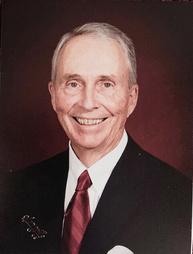





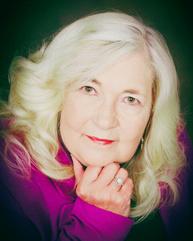

39 designing lighting global E d i s o n R e p o r t ' s 2 0 2 3 L I F E T I M E A C H I E V E M E N T A W A R D R E C I P I E N T S J o i n u s o n M o n d a y , M a y 2 2 a t L i g h t F a i r a s w e r e c o g n i z e t h e i r A C C O M P L I S H M E N T S a n d C O N T R I B U T I O N S t o l i g h t i n g . RSVP here Synergy 21239 Broadway, 2nd Floor New York, NY 10001
Mark Benguerel
Larry Bloch
Larry Comer posthumous
Cheryl English
Lisa Heschong
Alan Lewis
Rebecca Rainier
Steven Rosen
Suzan Tillotson
John Tremaine
INNOVATION
New architectural lighting products available for specification
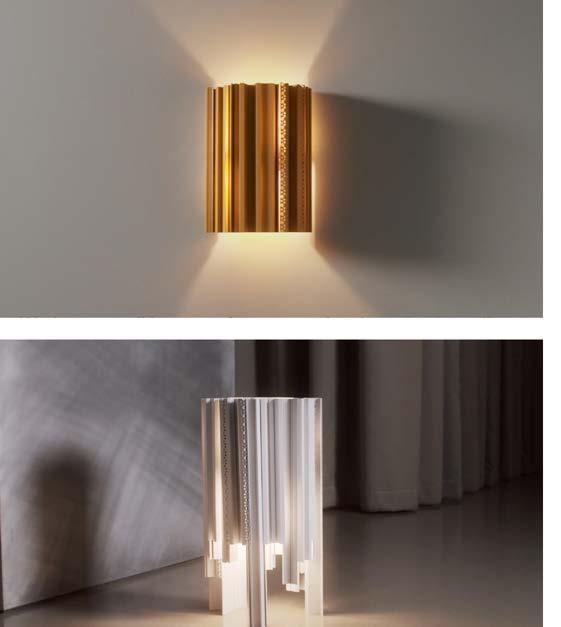
INVIA ERCO
What if a light structure could take on all architectural lighting tasks – including wallwashing in museums and galleries, general lighting in public buildings and standard-compliant task lighting in offices?
That was the question ERCO asked itself when it developed the Invia 48V modular light structure. It not only includes diffuse light lines but is a fully-fledged system for all architectural lighting tasks ranging from general illumination to accenting, and also offers technical lighting innovations such as continuous wallwashing right into corners. Digital connectivity and tunable white are options.

www.erco.com

HIGH PROFILE Delta Light
NICK Minimis
At just 21mm diameter and only a startling 500 microns in elevation and with a micro aperture of 2mm x 9mm, Minimis says the NICK is the world's smallest recessed directional luminaire. Developed specifically for grazing of walls and stair-treads in both indoor and outdoor environments, it is suitable for IP67 installation in any application, including extreme environments such as marine, arctic, and desert conditions. It consists of precision, hand-milled grade-5 titanium and can be recessed into horizontal or vertical surfaces of stone, wood, concrete and drywall.
www.minim.is
Delta Light has teamed up with Dutch architecture firm MVRDV to create a range of striking luminaires made from waste offcuts of aluminium profiles. The High Profile series is a range of light fittings which ‘finds both opportunity and beauty in residual elements that would normally be cast aside’, says the firm. Reusing it in the High Profile range – which includes pendants, wall fittings and freestanding luminaires – has the least environmental impact. The series includes a cube-shaped pendant luminaire, a wall fixture and a freestanding model.
www.deltalight.com
NOS SPHERE 228 Diplomat Design
Created by designer Matthew Kavanagh, the Nos Sphere 228 chandelier is part of a range of lights made from recycled laughing gas canisters. ‘I've been seeing these canisters littering the streets as I cycle around London and thought it was an incredible waste of a beautifully engineered single-use component,’ says Kavanagh. Each light uses 228 canisters, which are machined, threaded, polished and assembled by hand. A single narrow-focus recessed LED spotlight illuminates the chandelier to provide drama and movement.

www.diplomatdesign.com
LINNÉ Valmont
A French company has unveiled a lighting concept which combines a street luminaire and a tree-like frame of growing foliage. The Linné from Valmont is a combination of public illumination and horticulture, designed to bring biodiversity into urban environments.

Composed of a modular structure on which voluble climbers come to settle, the Linné mast contributes to the reintroduction of living elements into the city where trees cannot take root. It comprises a central pole and four articulated arms, the multiple orientations and inclinations of the latter allow significant modularity of shapes and vegetation.
www.valmont.com
40 designing lighting global
KVISTEN Fagerhult
Kvisten is made from 77 per cent recycled or renewable materials, including a body is made entirely of pine plywood housing with Birch veneer. An innovative new louvre reduces plastic by 50 per cent compared to the company’s conventional microprism. Only 180g of virgin plastic is used in each fixture, and the packaging is plastic free. Fagerfult engineers say that, despite its environmental credentials, the Kvisten doesn’t compromise on either visual comfort or efficiency; it delivers with up to 144 lm/w and features integral lighting controls and UGR of <19. www.fagerhult.com
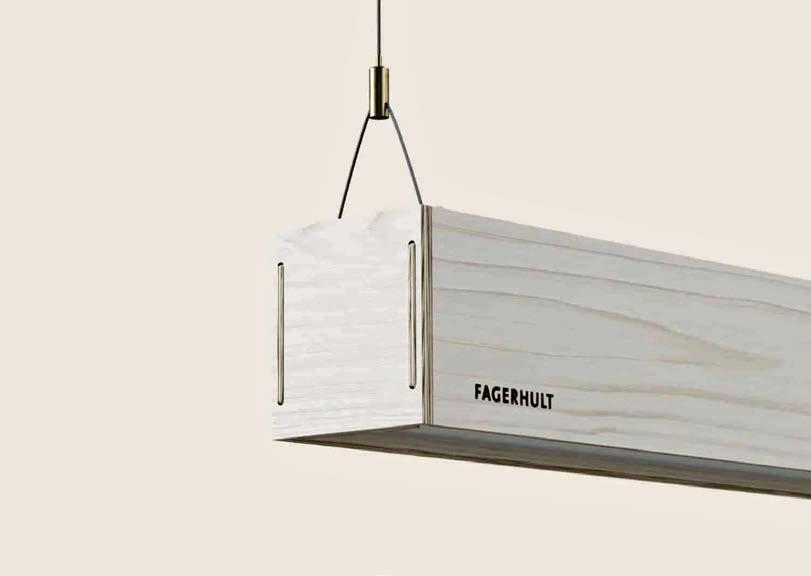
COASTAL BREEZE Signify
Signify has unveiled a range of lamps 3D printed from discarded fishing nets.
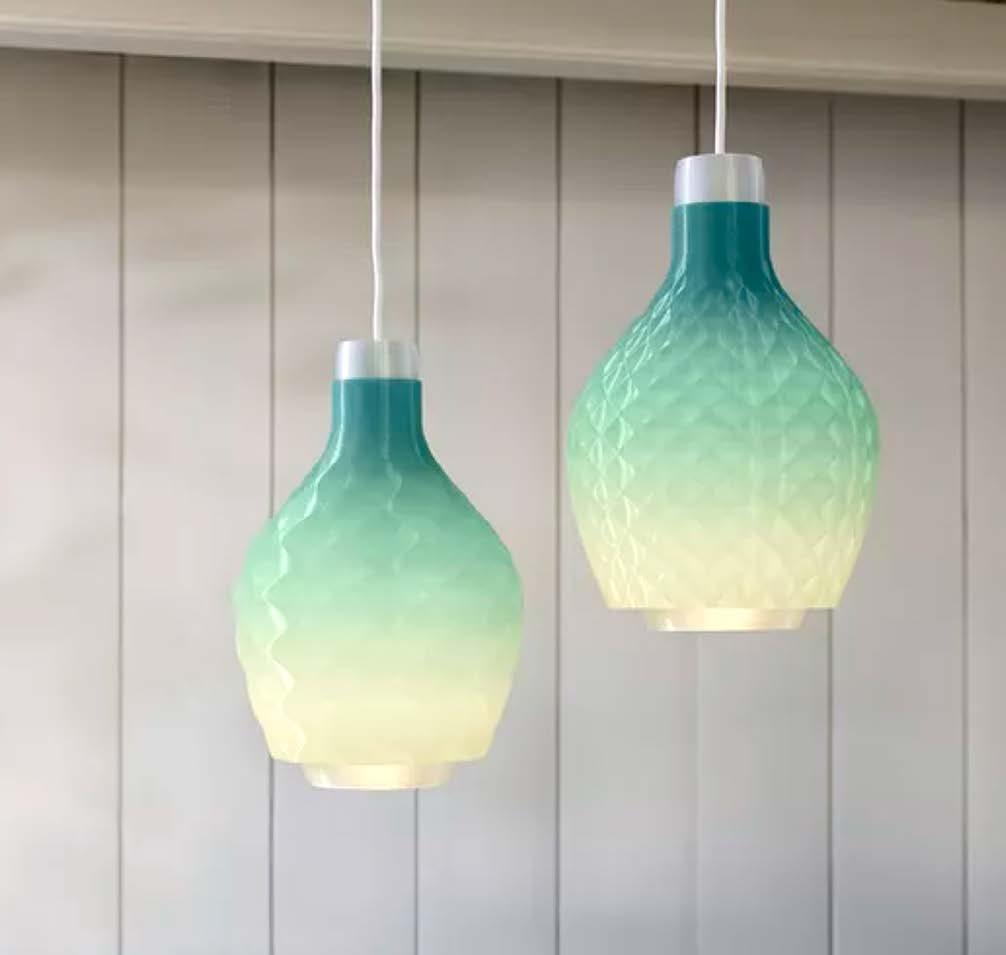
The ‘Coastal Breeze’ collection of sustainable pendant luminaires uses so-called ocean plastic made from plastic rescued from the sea. Up to 46 per cent of ocean plastic consists of fishing nets, lines and ropes. These can often endanger the lives of marine wildlife. Transforming this waste into 3D filament disposes of 4.5 meters of fishing net per luminaire. Original nylon fish nets are sourced from fishermen on the UK’s Cornish coast and transformed into granulate, which is then 3D printed.
www.signify.com
AURA
Established & Sons
The Aura range of luminaires is made with a bio-epoxy resin manufactured using byproducts from the agricultural industry. The result of a collaboration between British brand Established & Sons and Rotterdam-based designer Sabine Marcelis, it consists of two linear pendants made from cylindrical bars of the pastel-hued bioplastic resin. Over a metre in length and coloured in soft tones of yellow and coral, the translucent Aura lights take their name from the warm glow they emit when illuminated. Inside is a replaceable glass LED tube.

www.establishedandsons.com
TRISEL Olev Light
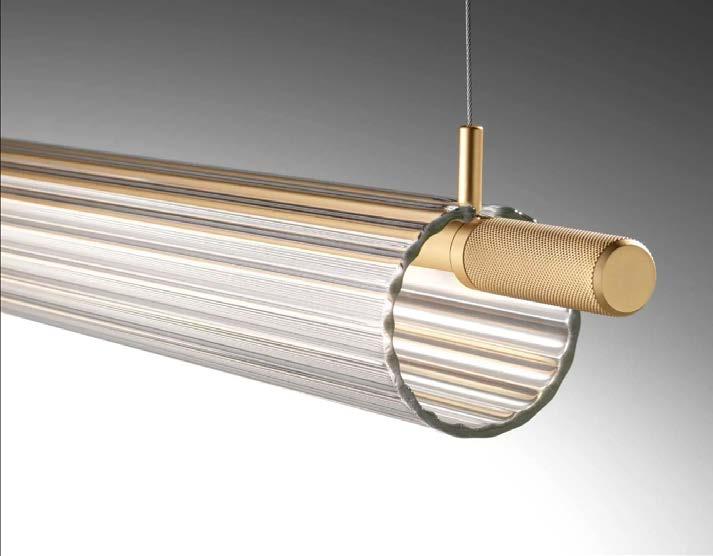
Trisel is a suspension lamp in aluminium and ribbed borosilicate glass designed especially to be suspended over a dining table. The knurled engravings of the metal rod ends are allowed to protrude from the glass. It’s a delicate geometric pattern that shows exquisite attention to detail.
All the colours available for the Trisel lamp –burnished, black, gold, earth and titanium are made with liquid paint, which is applied entirely by hand. The luminaire can be integrated with dimming and light adjustment technologies to have a warmer or cooler light at any time.
www.olevlight.com
GAVIN SILENCE LEAF Olev Light
Designed by Massimo Tonetto, Leaf is a range of LED suspension lights with a lush upside-down garden. The Gavin Silence Leaf is a lamp comprising a LED light ring, inside of which there is a sophisticated composition of real leaves which, thanks to a stabilisation treatment, do not require any water or maintenance, and remain intact and vivid over time. The light is designed to be comfortable for the eyes, and to improve acoustic comfort in the room, through a sandwich of porous materials that make up the leaves housing.

www.olevlight.com

41 designing lighting global
LIGHTING AWARDS COMPETITION
The IALD International Lighting Design Awards
FINAL SUBMITTAL DATE 15 February 2023
ANNOUNCEMENT DATE EST June 2023
LIT Design Awards
FINAL SUBMITTAL DATE 22 October 2023
ANNOUNCEMENT DATE EST November 2023
Light Middle East Awards
FINAL SUBMITTAL DATE EST November 2023
ANNOUNCEMENT DATE EST January 2024
iF Design Award 2023
FINAL SUBMITTAL DATE 10 November 2022
ANNOUNCEMENT DATE mid-April 2023

AWARD NIGHT 15 May 2023, Berlin
Build Back Better Awards

(Lighting Category) OPEN FOR ENTRIES 24 April 2023
FINAL SUBMITTAL DATE 28 July 2023
ANNOUNCEMENT DATE 14 September 2023
42




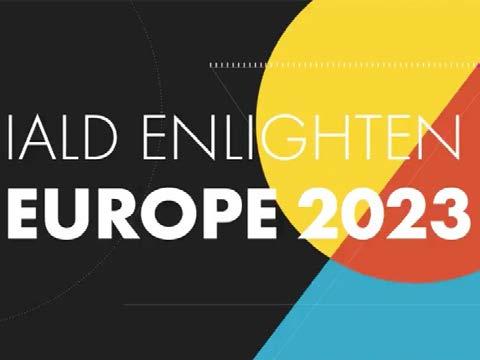





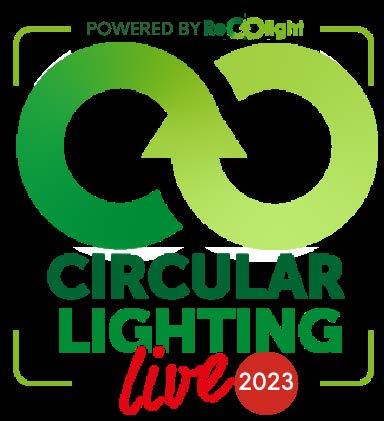
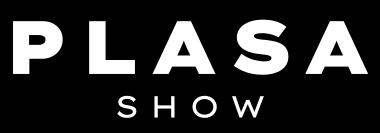

43 designing lighting global TRADE SHOWS 18-23 APR 2023 MILAN 21-25 JUN 2023 NEW YORK 9-12 JUN 2023 GUANGZHOU 30 JUN - 1 JUL 2023 BERLIN 21-22 NOV 2023 LONDON 28 FEB - MAR 3 2024 TOKYO 2-8 MAR 2024 FRANKFURT 21-22 NOV 2023 LONDON 27-30 OCT 2023 HONG KONG 21 SEP 2023 LONDON 3-5 SEP 2023 LONDON 16-18 JAN 2024 DUBAI 43 designing lighting global
ORG NEWS
BERLIN TO HOST ENLIGHTEN EUROPE 2023
Berlin has been named by the International Association of Lighting Designers as the host city for this year’s Enlighten Europe 2023 conference. Returning to the European continent for the first time since 2018, the event takes place
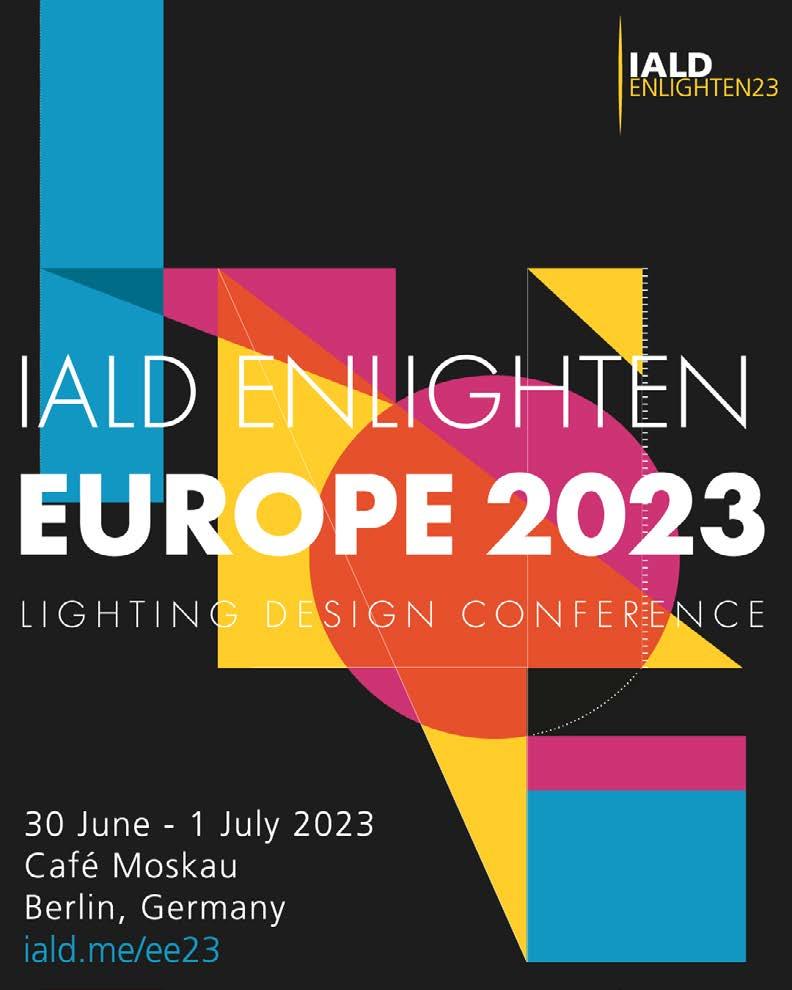
From 30 June to 1 July 2023 and brings back the camaraderie and professional advancement of two days spent in the company of lighting design professionals from around the world. The gathering – at the striking 1960s-era Cafe Moskau conference centre – includes educational sessions, deepdive talks with peers, announcements from the IALD directly and more.
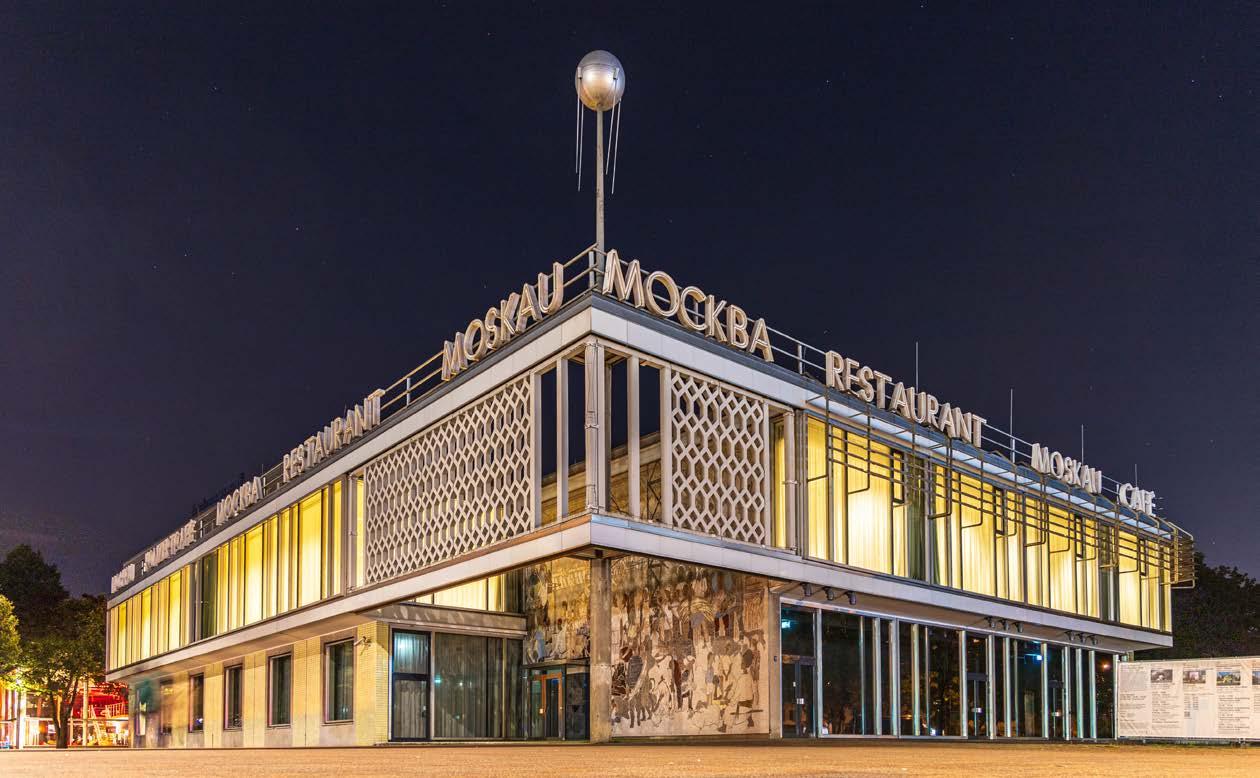
Enlighten Asia is slated to take place on 15 to 16 November 2023 in Tokyo.
https://iald.org/Events
LUCI PLANS A STRING OF EVENTS IN 2023
The Lighting Urban Community International is planning a number of events for 2023.
The LAiPS Final Conference takes place on Thursday 2 November and Friday 3 November 2023 in Turin, Italy, taking place during the Luci d’Artista light festival.
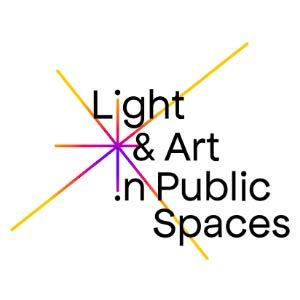
Project partners will share the learnings over the three years of the project and participants will hear from experts of the creative lighting field on the topic of light and art and its intersection with many urban trends.
Find information about the LAiPS project here
LUCI will also be participating in the Lyons Light Festival Forum 2023 on Thursday 7 December and Friday 8 December.

It also says it will be holding its next Urban Lighting Workshop in Asia. Dates to be announced.

44 designing lighting global
COMING UP IN
designing lighting global Issue 2:

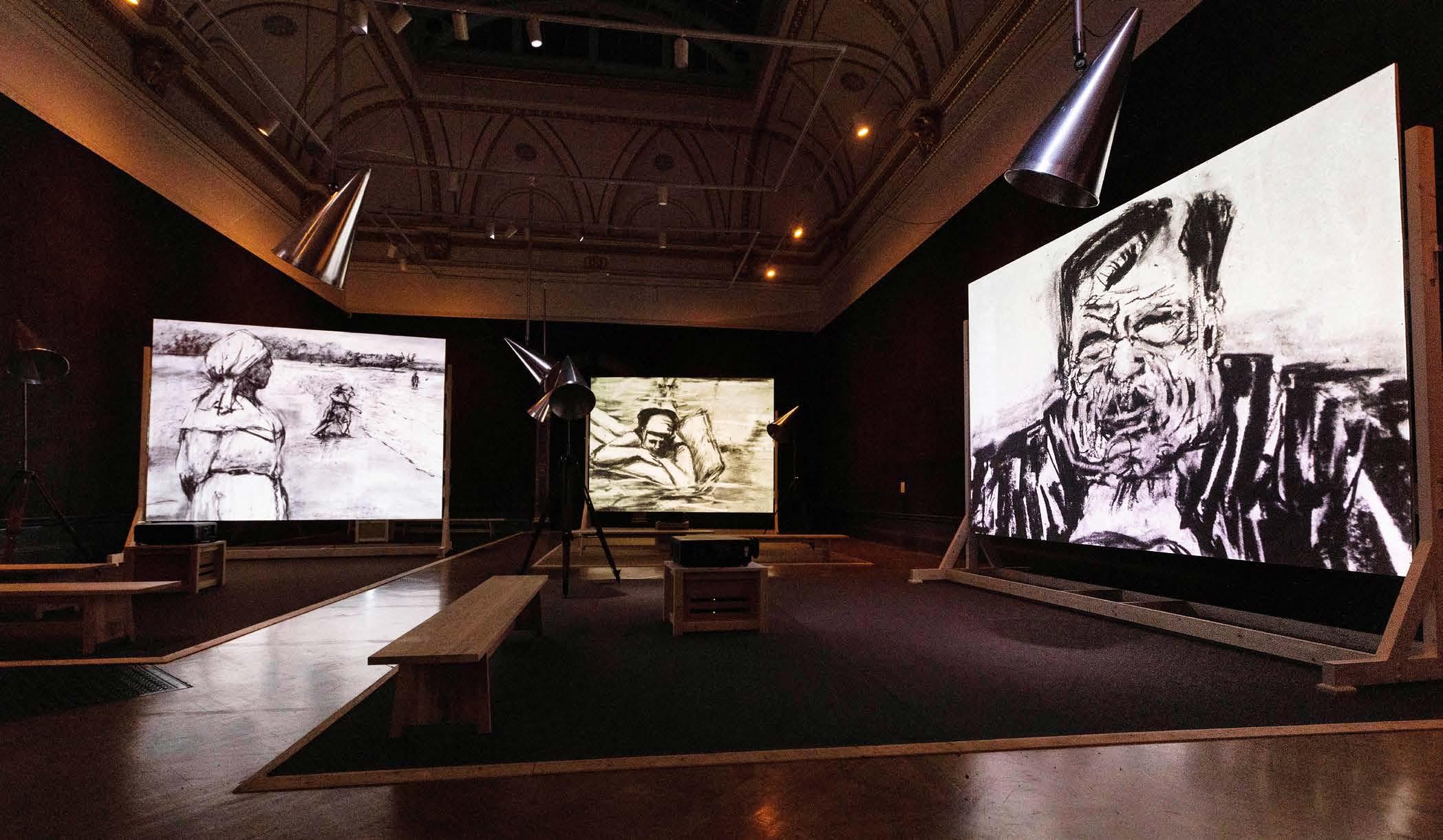
■ Lighting Art and Objects
■ Social Inclusion
■ Lighting Plants and Green Walls
PUBLISHED IN JUNE 2023. EDITORIAL AND ADVERTISEMENT COPY DEADLINE: 24 MAY 2023.
designing lighting global Issue 3:
■ Wireless Controls
■ Lighting, Sustainability and the Circular Economy
■ Retail Lighting
PUBLISHED IN SEPTEMBER 2023. EDITORIAL AND ADVERTISEMENT COPY DEADLINE: 16 AUGUST 2023.
designing lighting global Issue 4:
■ Landscape Lighting Special
■ Lighting Plants and Green Walls
■ Light 23 Preview
PUBLISHED IN NOVEMBER 2023. EDITORIAL AND ADVERTISEMENT COPY DEADLINE: 18 OCTOBER 2023.
45 designing lighting global
Gallery view of the William Kentridge exhibition at the Royal Academy of Arts, London © William Kentridge.
Photo: © Royal Academy of Arts, London / David Parry. We report on the lighting by DALD in the next issue.
salutes and thanks its advertisers for their support. We applaud the achievements of lighting practitioners and recognize the importance of their work in architecture and design.




46 designing lighting global
page 5 page 23 page 7







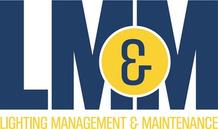

E d i s o n R e p o r t F A M
T H E
I L Y
Duncan Meerding UP CLOSE with
A discreet building tucked in behind a Dulux paint trade centre in a suburb of Hobart, Tasmania, is the unlikely location for a luminaire design studio that’s making waves across the world for its on-trend creations in waste wood.
What’s even more remarkable is that the designer behind awardwinning creations such as Stump, Duncan Meerding, is legally blind.
Meerding has just 5 per cent of his sight remaining but he believes that this disability informs his distinctive designs: ‘The vision of light emanating from the peripheries of the different objects reflect the alternative sensory world within which I design,’ he says. ‘I focus on form and texture, and my designs draw heavily from the vast natural beauty of the Tasmanian wilderness.’
‘Much of my work features organic curving lines inspired by the local landscape. Many of my designs highlight the highly tactile nature of the materials used, embracing their natural characteristics, such as the bark that still clings to the objects in the Cracked Log series.
‘The relationship between light and shadow and light dispersion are also integral to my design process.’
Each Duncan Meerding design is created with a focus on longevity. By combining traditional hand-made techniques, modern manufacturing technologies and small-scale production, each object is built to last. Sustainability and care for the environment are present in every step of the design and manufacturing process.

The majority of timber used is sourced either from waste materials or else from faster-growing, robust timber varieties. As the practice has grown, care has been taken to insure that it stays true to the core principles of environmental sustainability, ethical practice and the relationship between the maker, the object and the customer.
‘Nature’s been involved in inspiring the designs,’ says Meerding.
‘This is particularly the case with the things like the Cracked Log Light range. Here I've actually physically got something that nature's created and embraced what happens to logs if they're
left in the elements.
‘I’m also embracing something which is often associated with flaws in the design and in the manufacture and made that a feature of the design.
‘A lot of my designs concentrate around how light goes through and around objects rather than the detailing.’ He speculates that that this may be a subconscious bias due to his partial sight and the fact that his vision is concentrated around the periphery.
Meerding, who studied furniture design at the University of Tasmania, also believes that making the items as well as designing them brings a different perspective.
‘There’s a bit too much of people sitting behind a computer and coming up with a pretty picture and then getting it made, and it breaks.
‘Sometimes having actual materials in front of you adds a bit of strength to the design process.
‘Making something also means you have that connection to the actual final object. For me it's really important where that object came from and how it was made.’
Meerding is increasingly getting recognised for his work and his unique perspective. Last year he was a guest teaching fellow and lecturer on ‘Architecture Beyond Sight’ at The Bartlett School of Architecture and Design at University College of London.
He regularly walks in the bush and hikes in the Tasmanian mountains, places where he reflects on the ‘primitive’ aspects of his work. His personal credo, too, is informed by his deep attachment to the natural landscape and his commitment to sustainability is equally primal.
‘We are actually on a tightly balanced ecosystem and we have finite resources and if we destroy it, we have nothing left. There’s isn’t a plan B.’ ■
48 designing lighting global



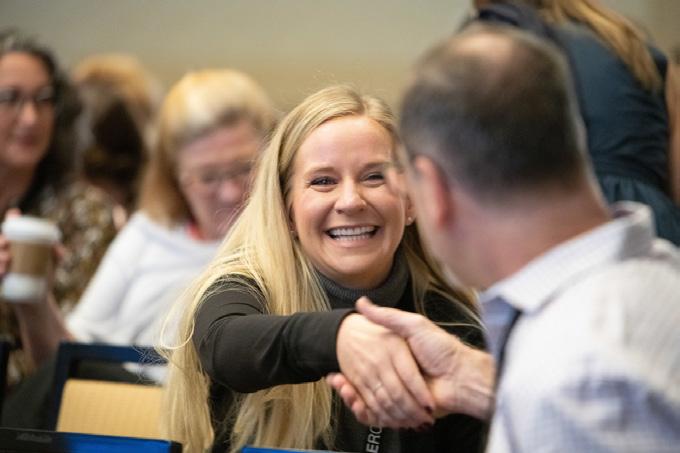

49 designing lighting global
EdisonReport.tv serves as a hub for all digital content in the lighting industry. A premier source for critical information surrounding lighting, EdisonReport.tv is dedicated to delivering industry news by way of video and serving its audience by spotlighting product launches and up-to-date educational videos, as well as information about upcoming webinars.

ThoughtLeaders at LEDucation 2023: Leela Shanker, Lighting Designer, Founder of LCA Incubator
Dan Weissman Interview: How 'Perception-Based' Lighting Can Deliver Sustainability

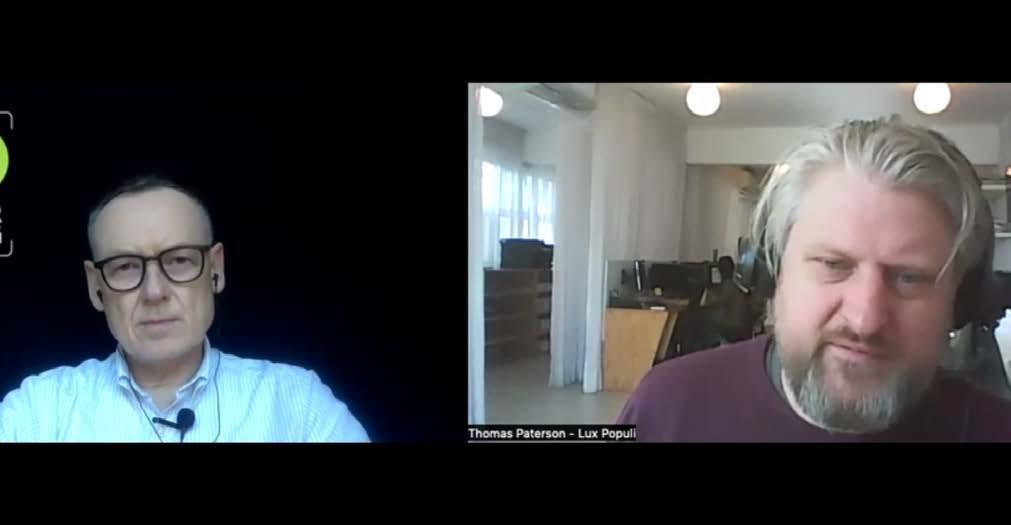
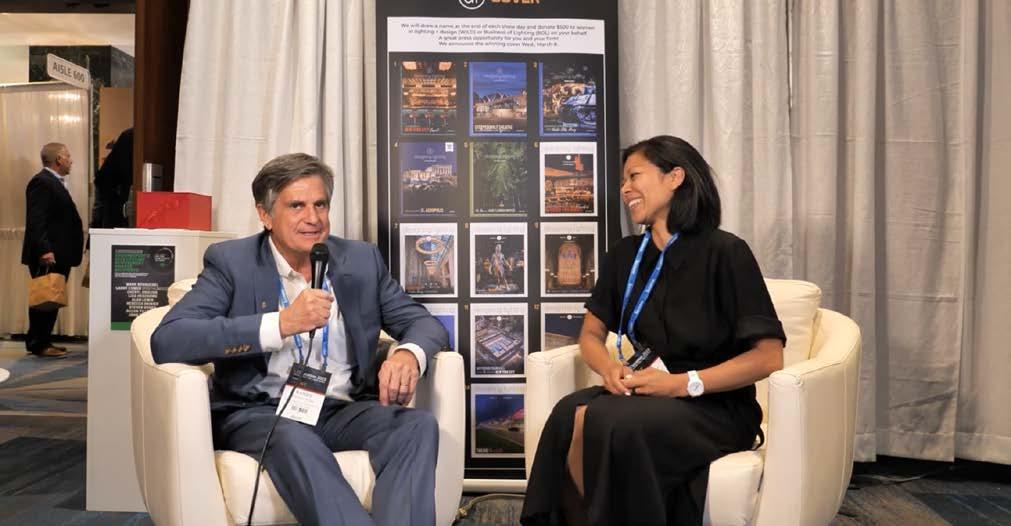

Thomas Paterson: 'We're asking clients to use renewable energy for our lighting schemes.'
Lessons from the 'Greenest Olympics Ever'
BUILD BACK BETTER AWARDS: Lighting the Kinder Building Using Edgex LED Technology
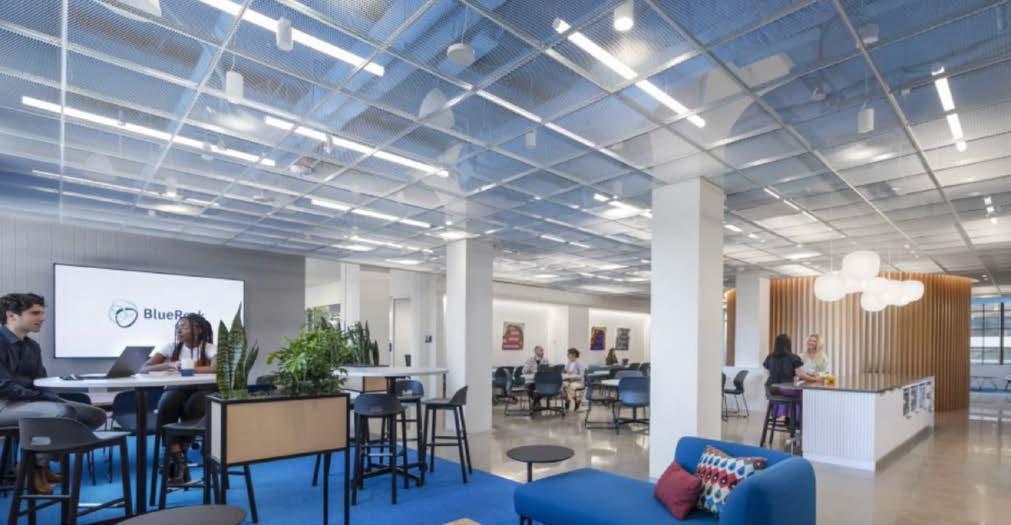

The Power of Lighting! A Conversation with Dr. Shelley James and Carol Talbot of The Possibility Hub
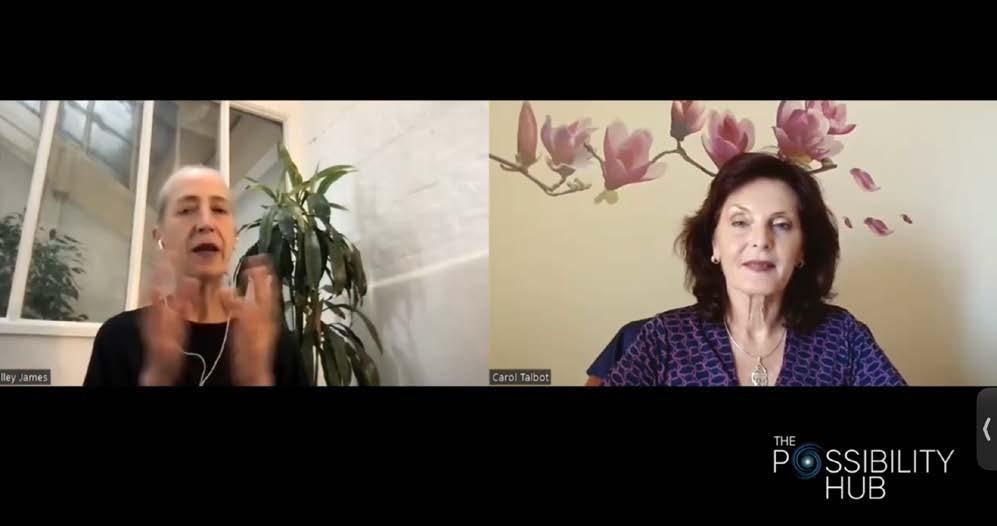















































 Nantong Grand Theater
Nantong Grand Theater



























 Midjourney is beginning to understand lighting techniques and already understands colour temperatures and concepts such as linear lighting.
Midjourney is beginning to understand lighting techniques and already understands colour temperatures and concepts such as linear lighting.



























 York Minster
Photo Credit: James Newton
York Minster
Photo Credit: James Newton



















































































































